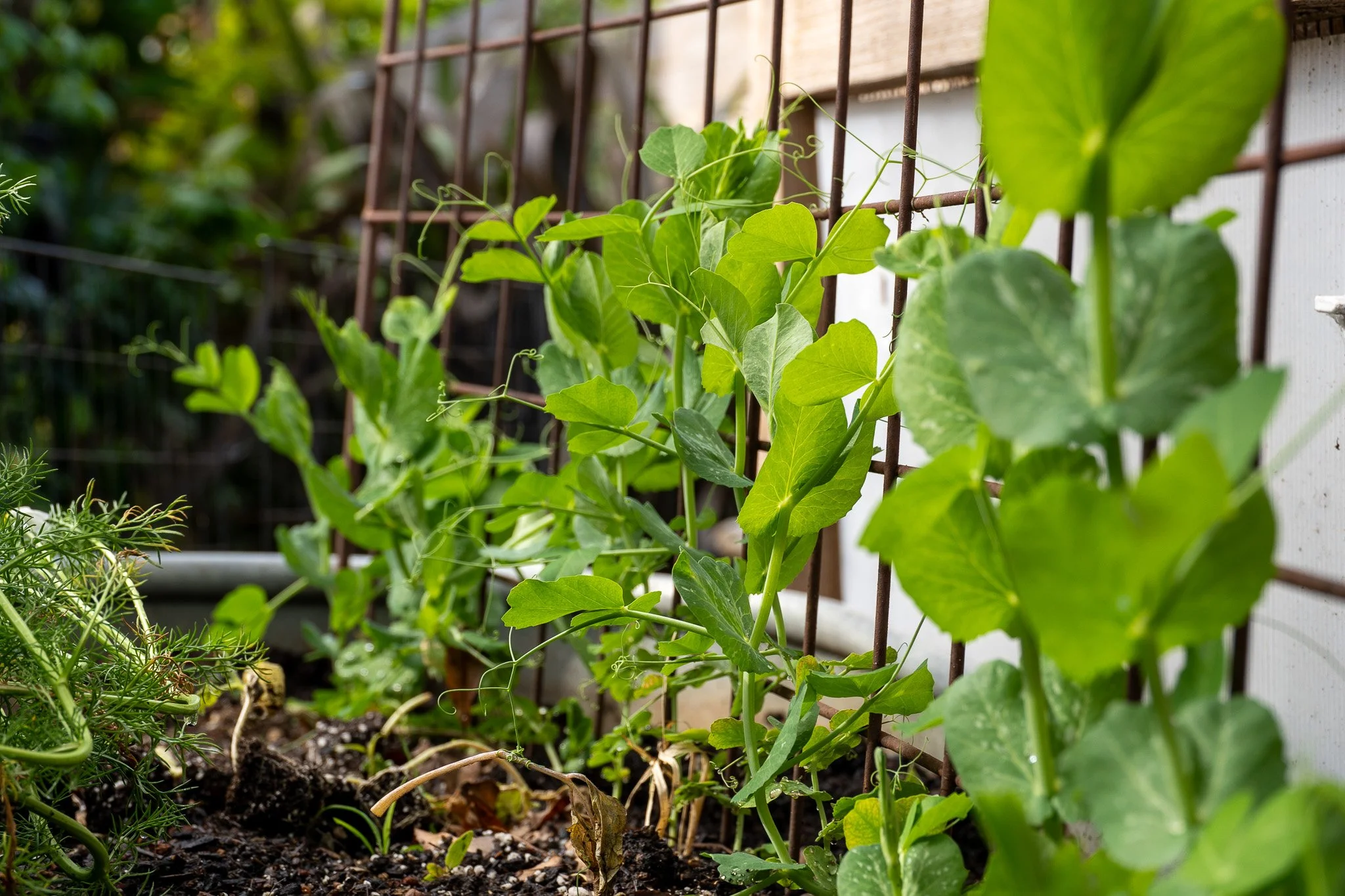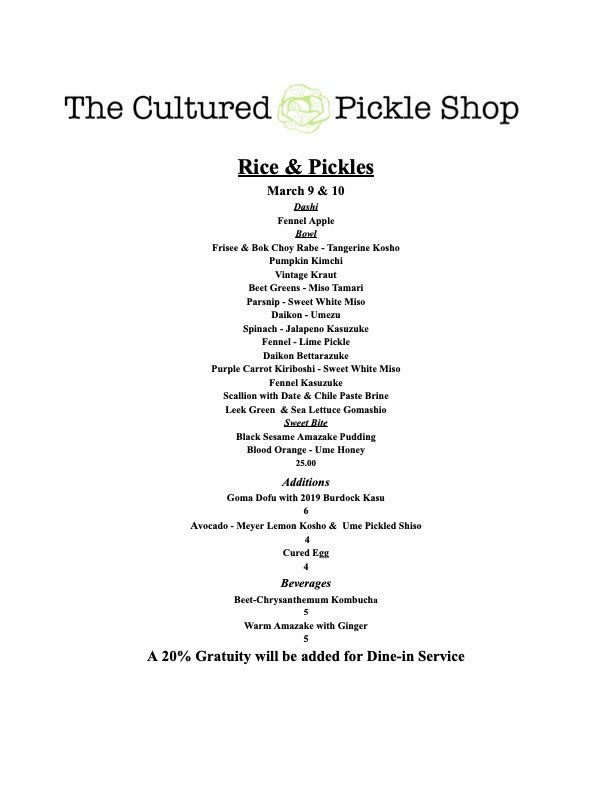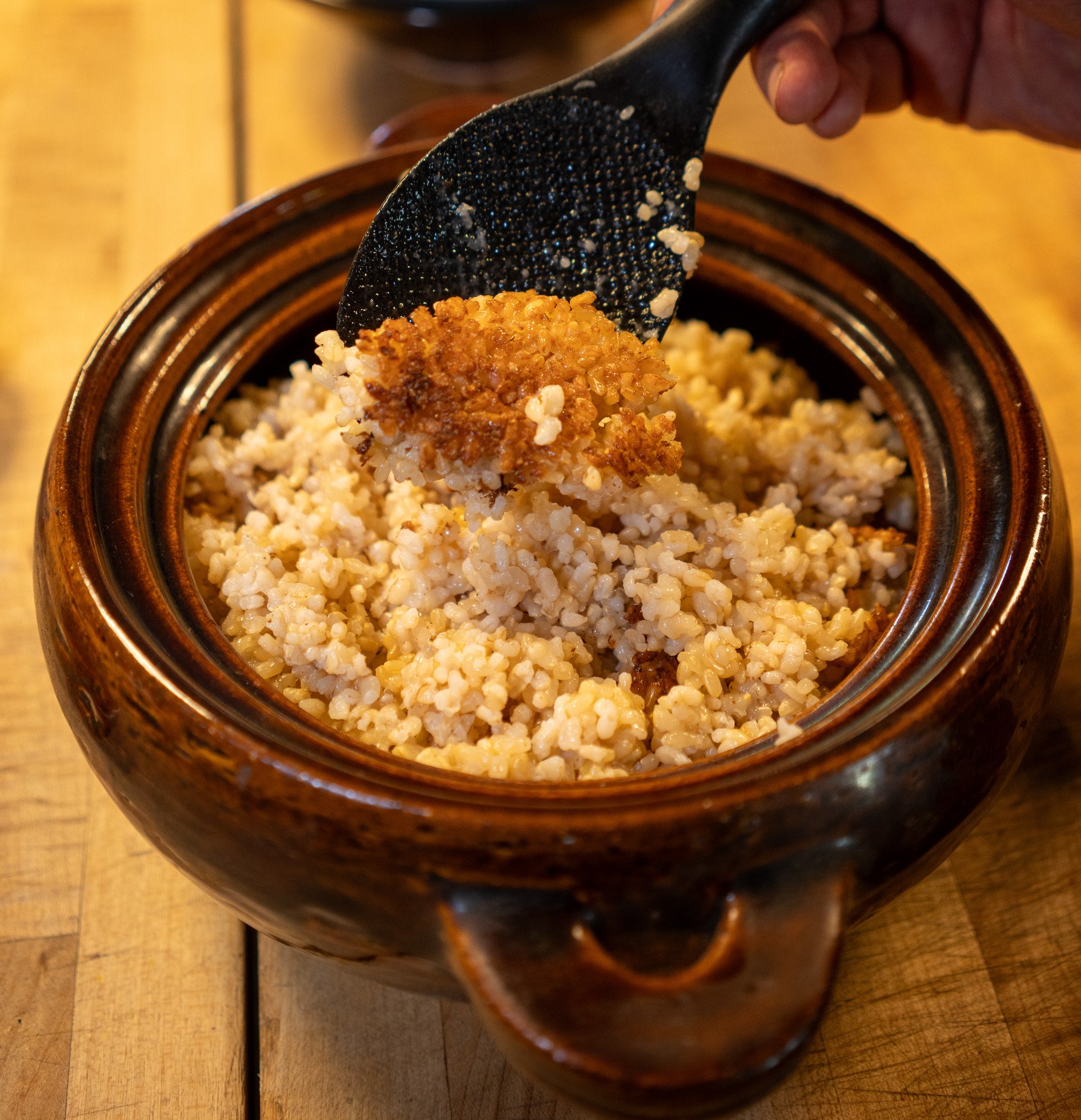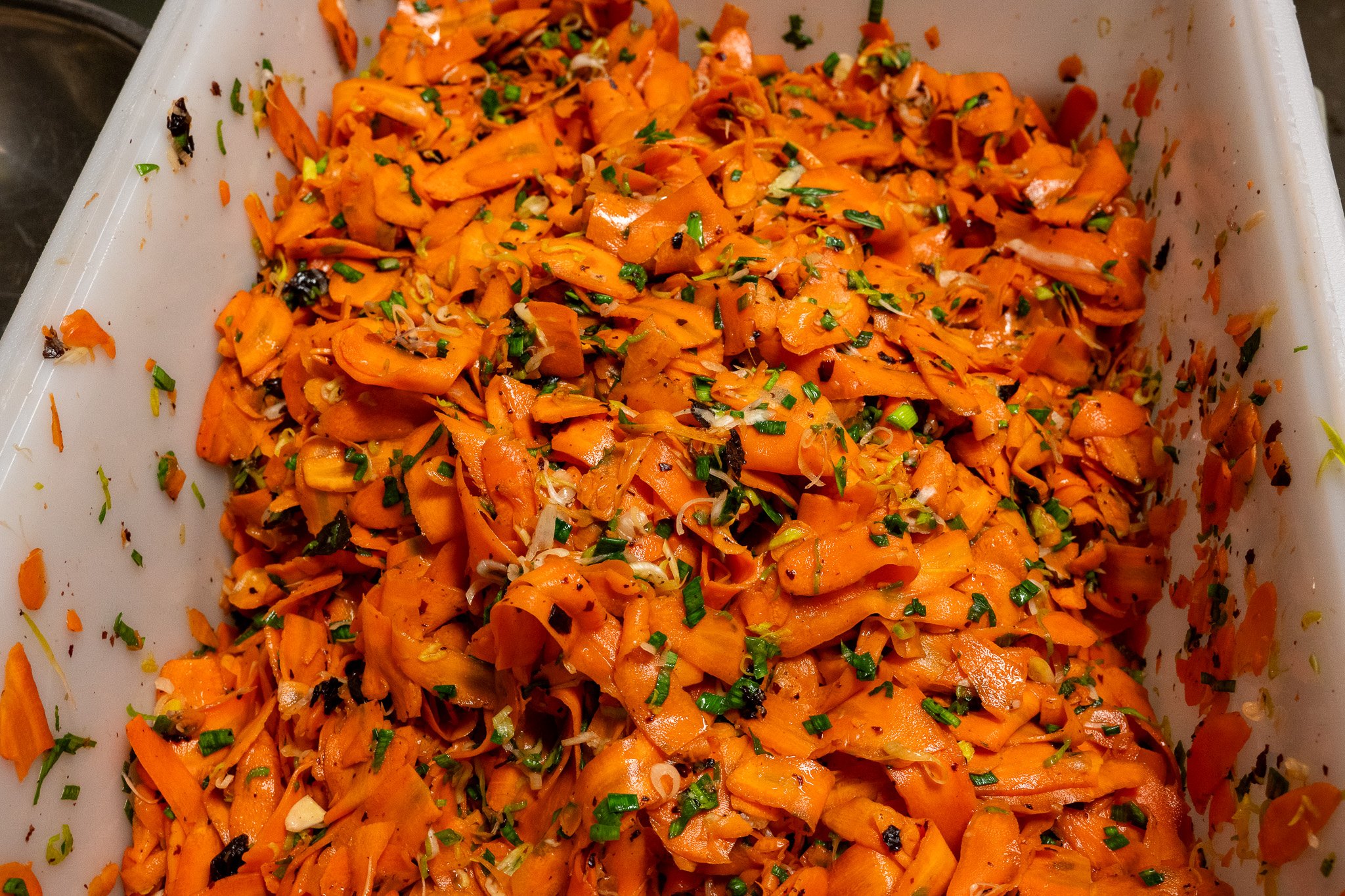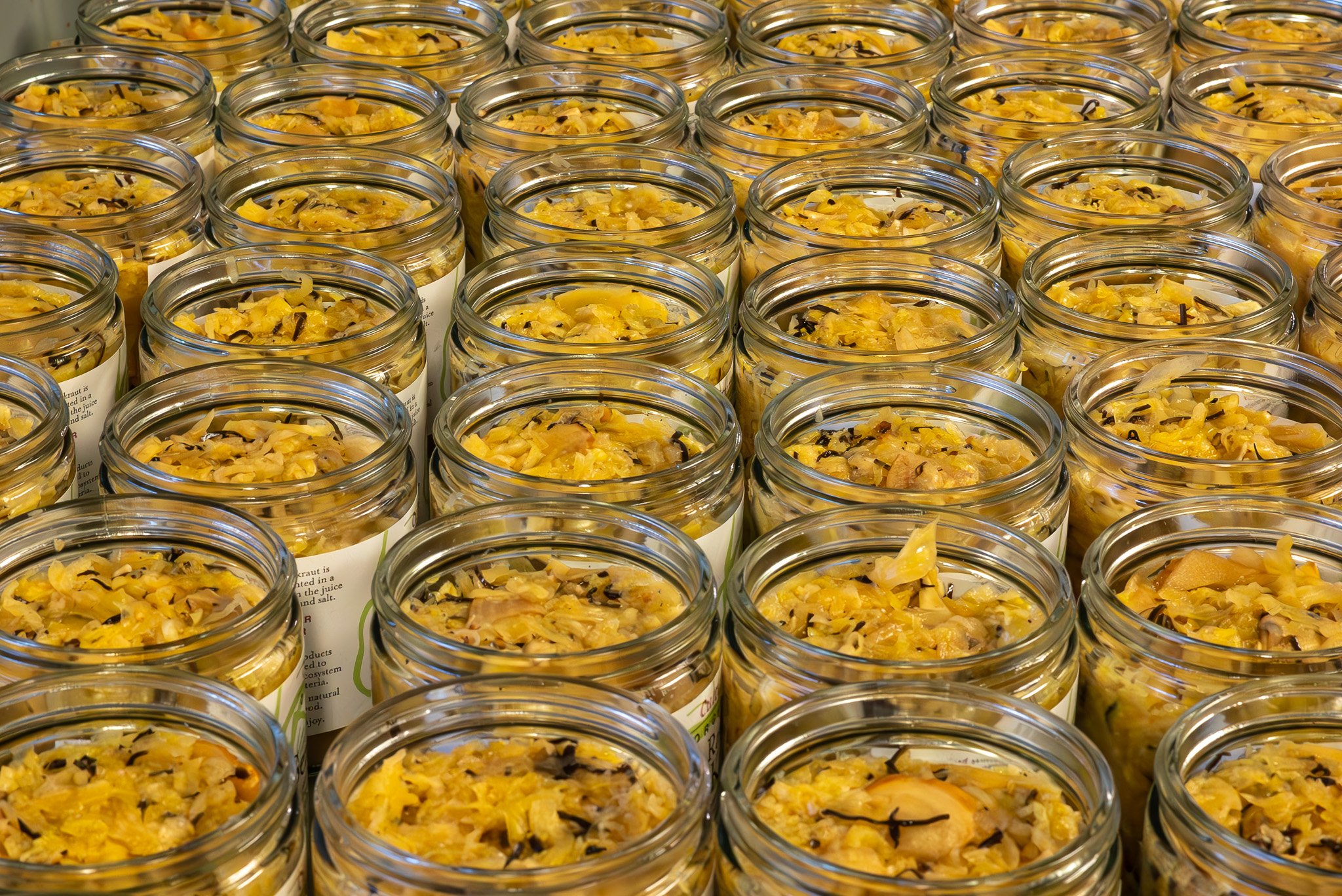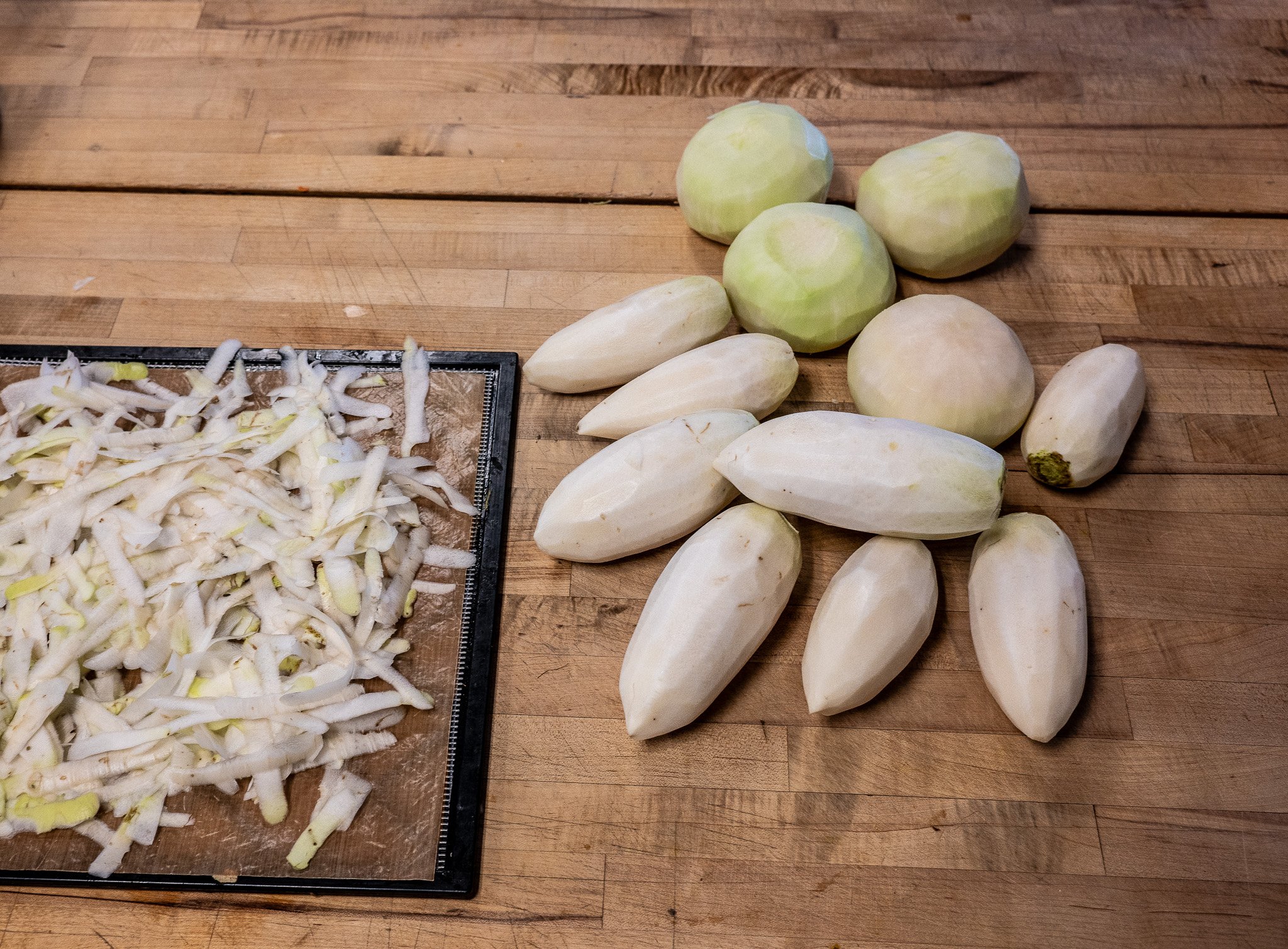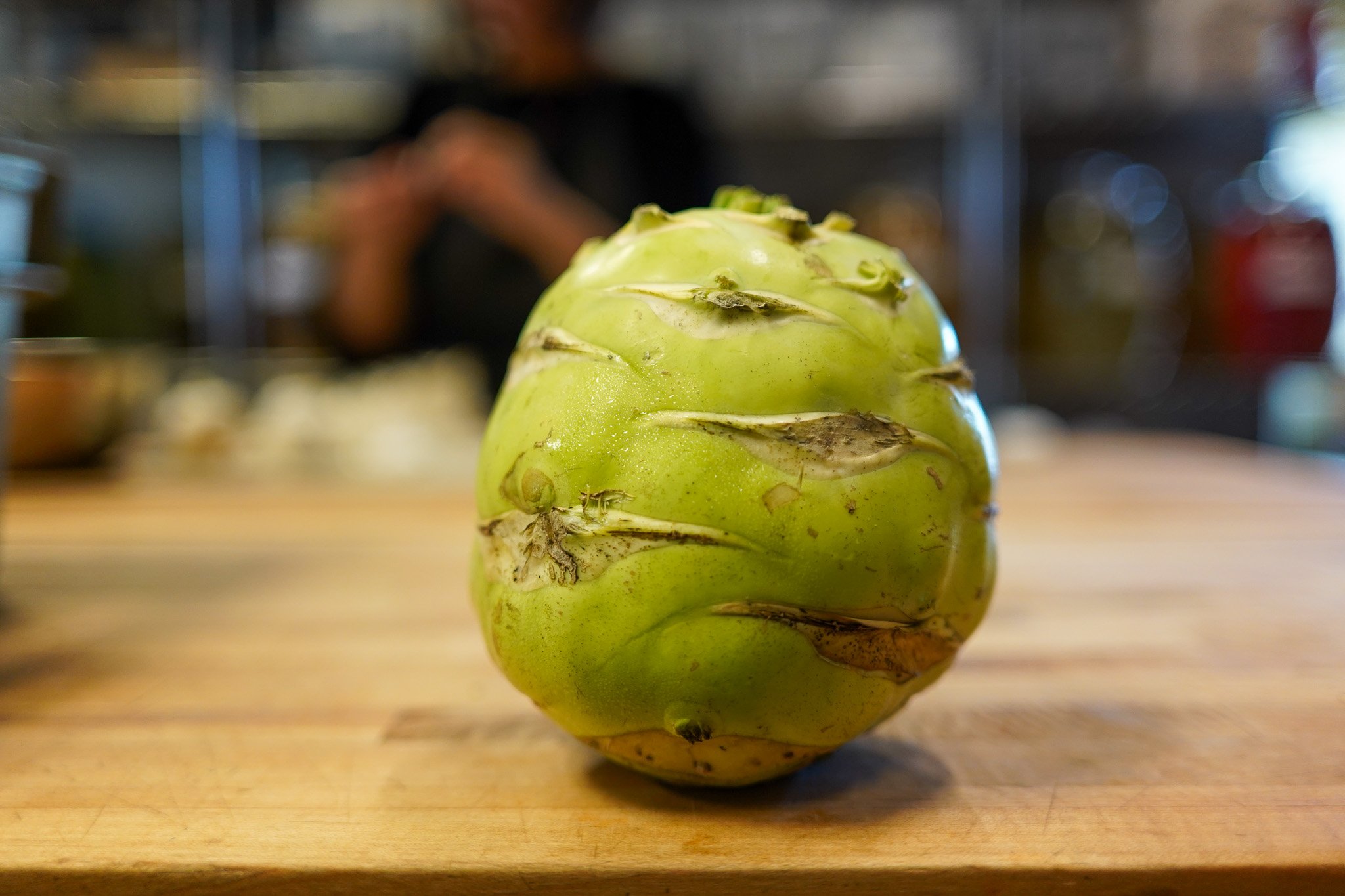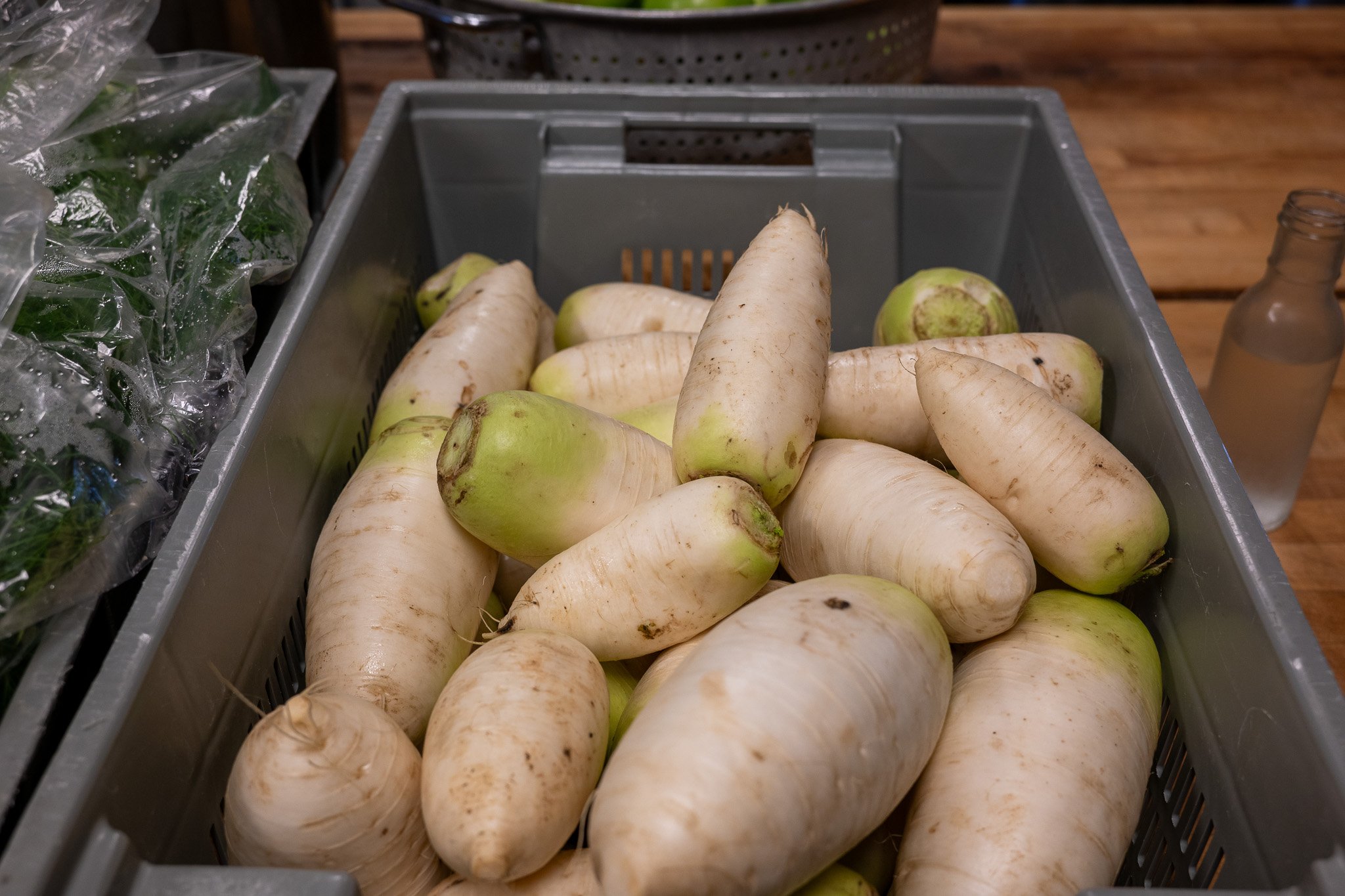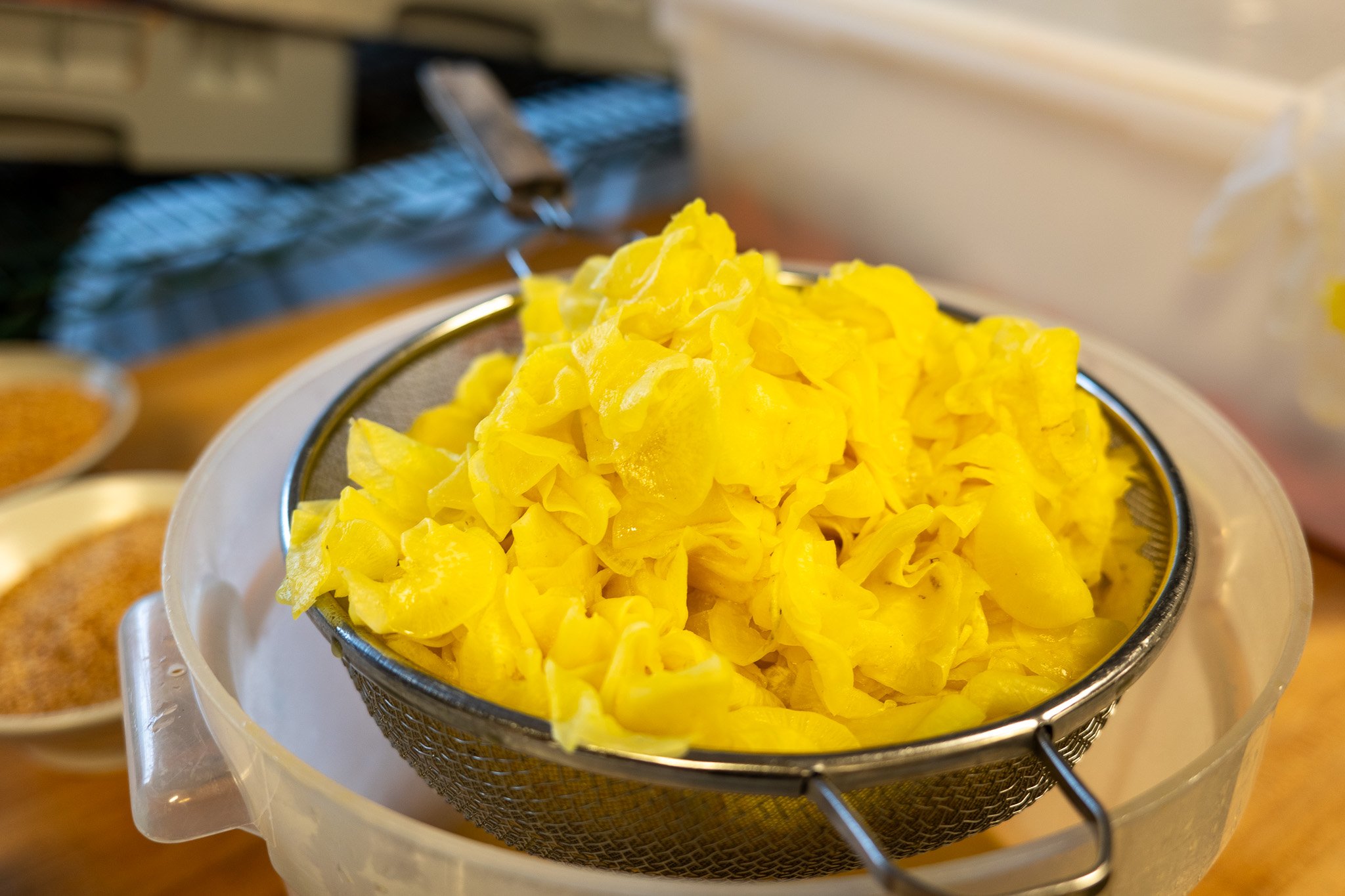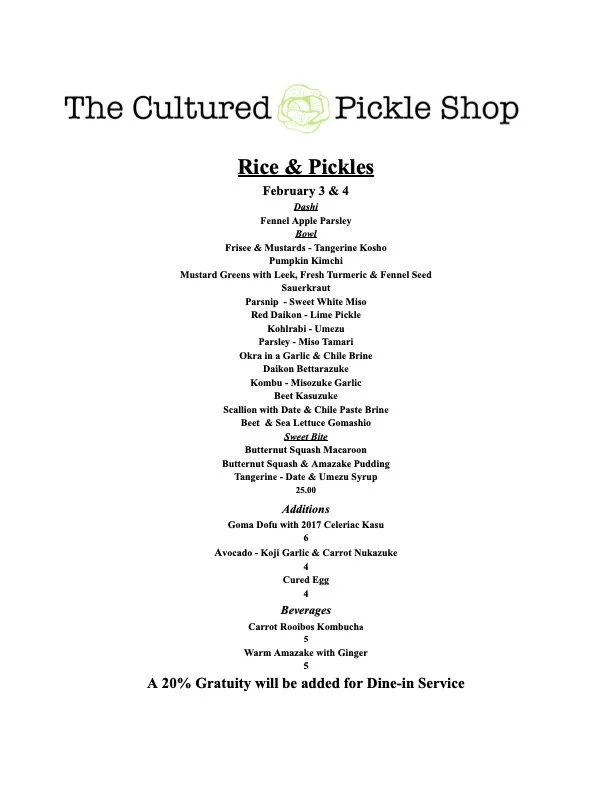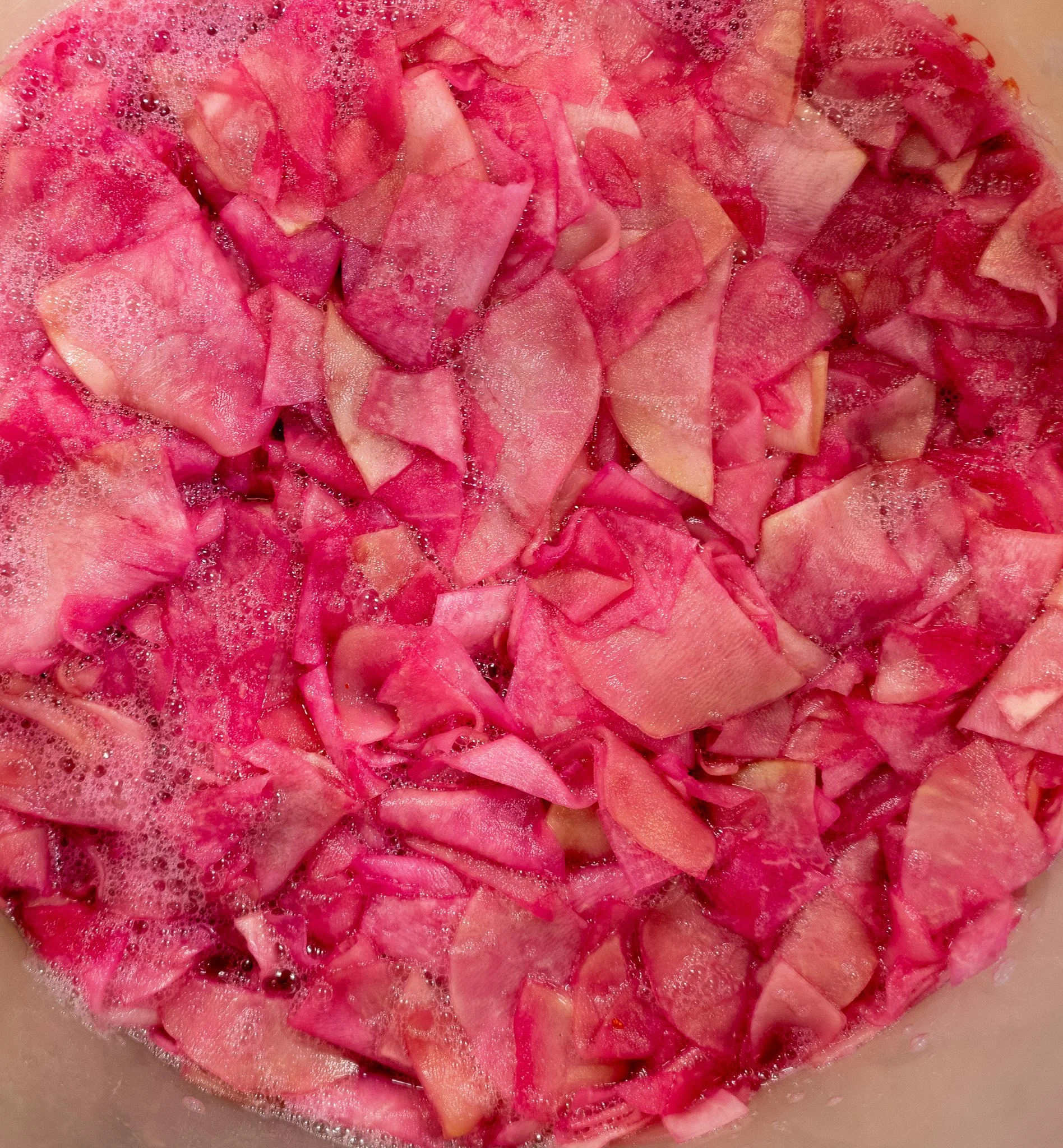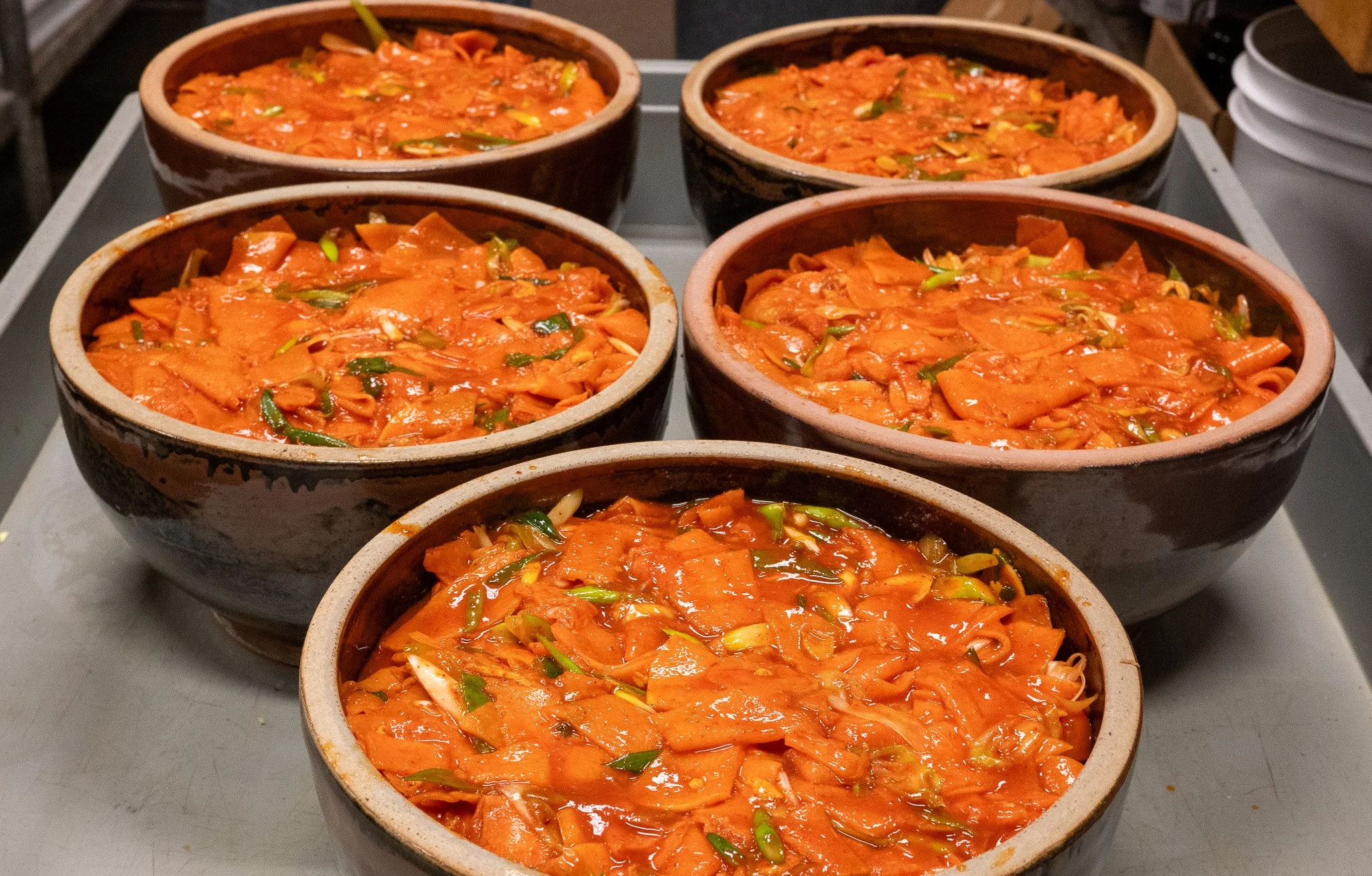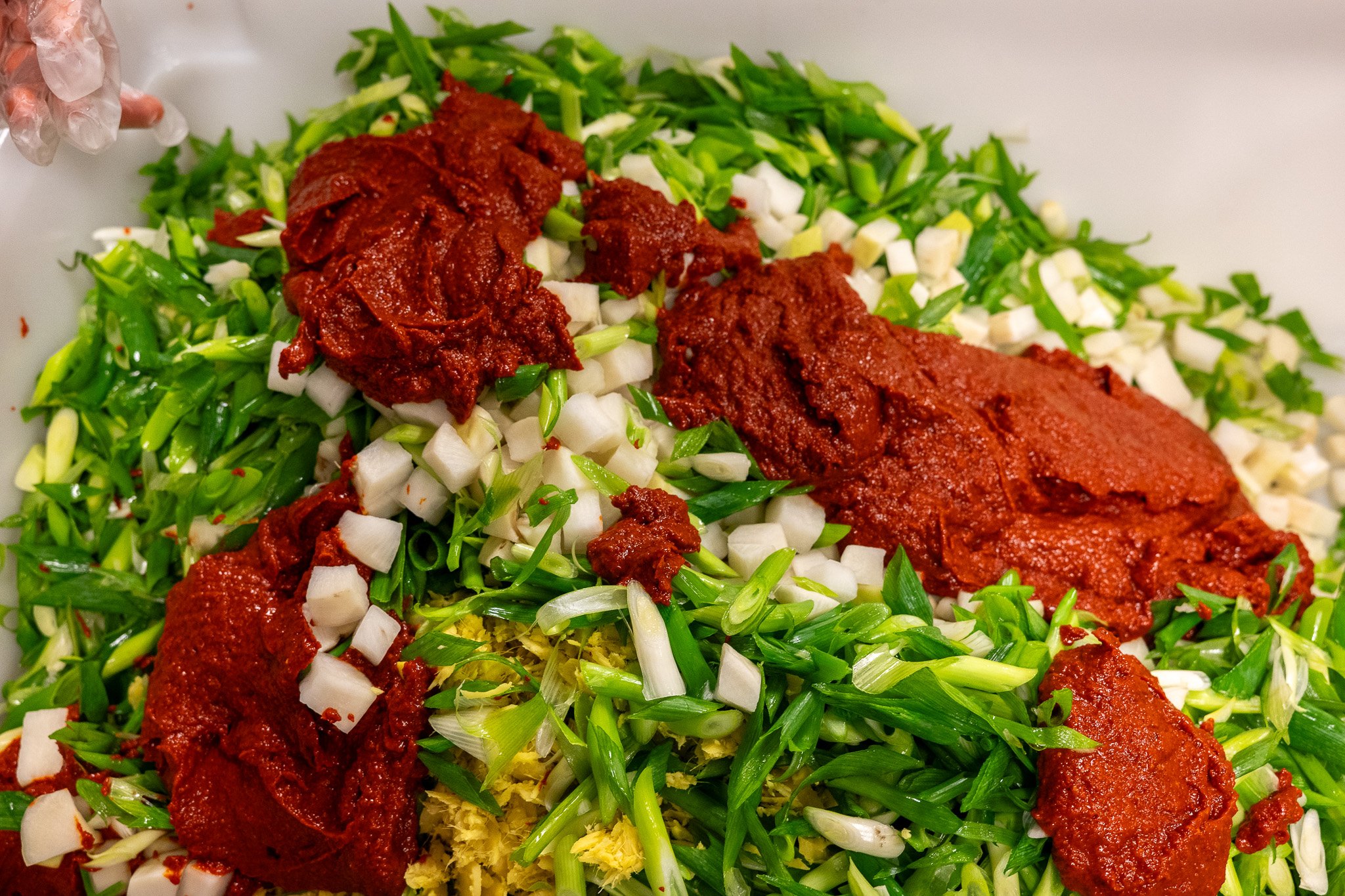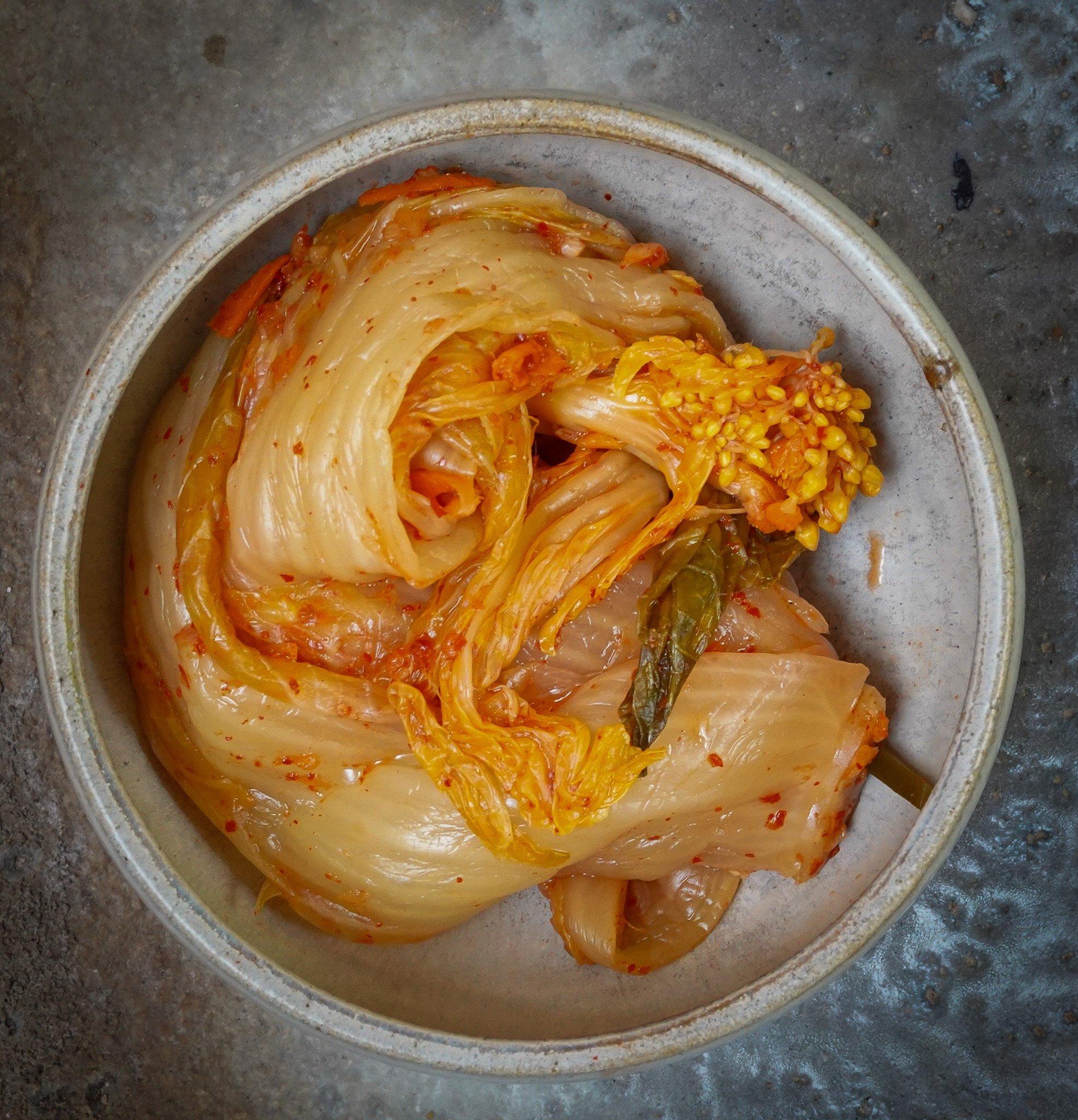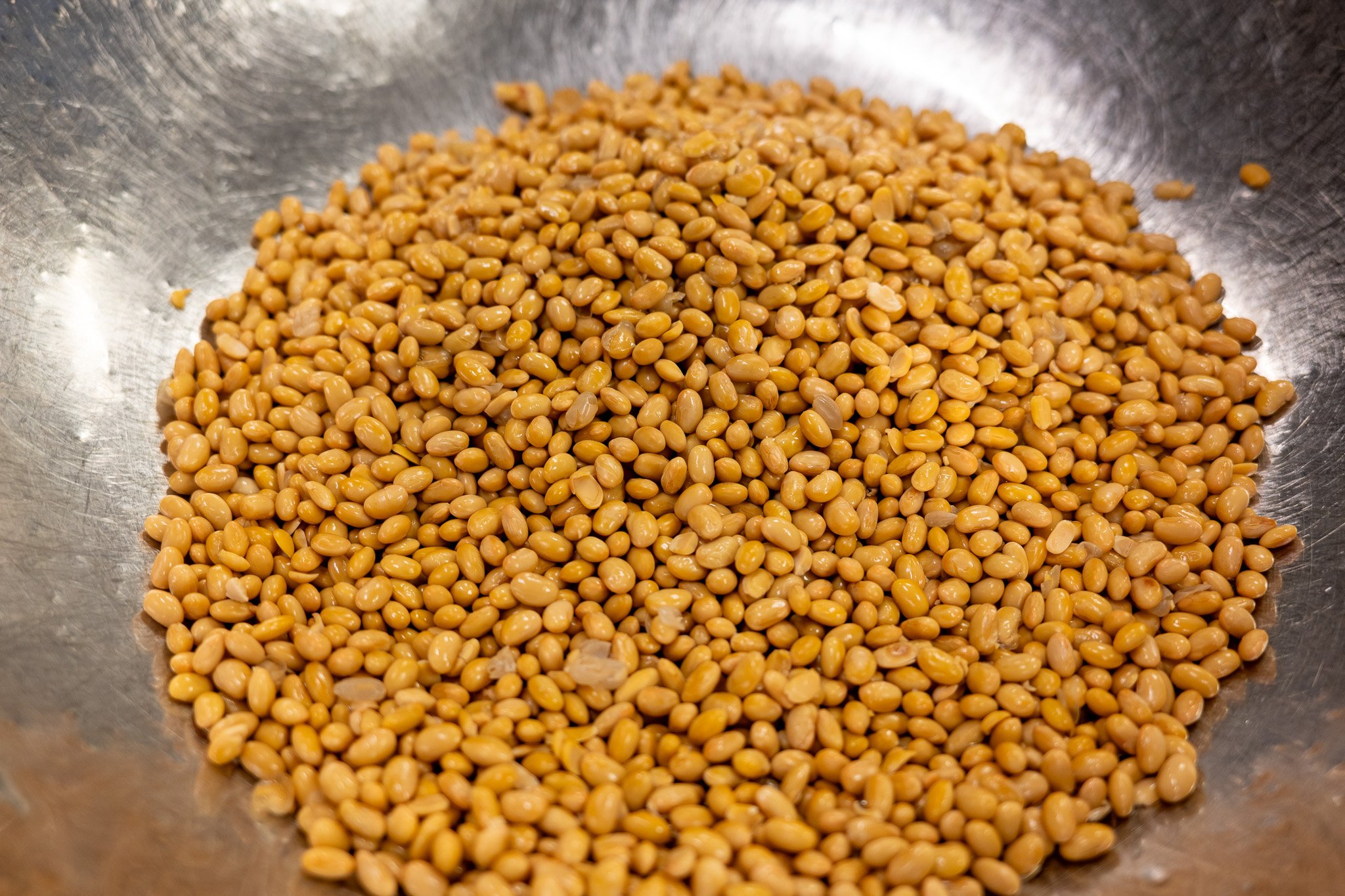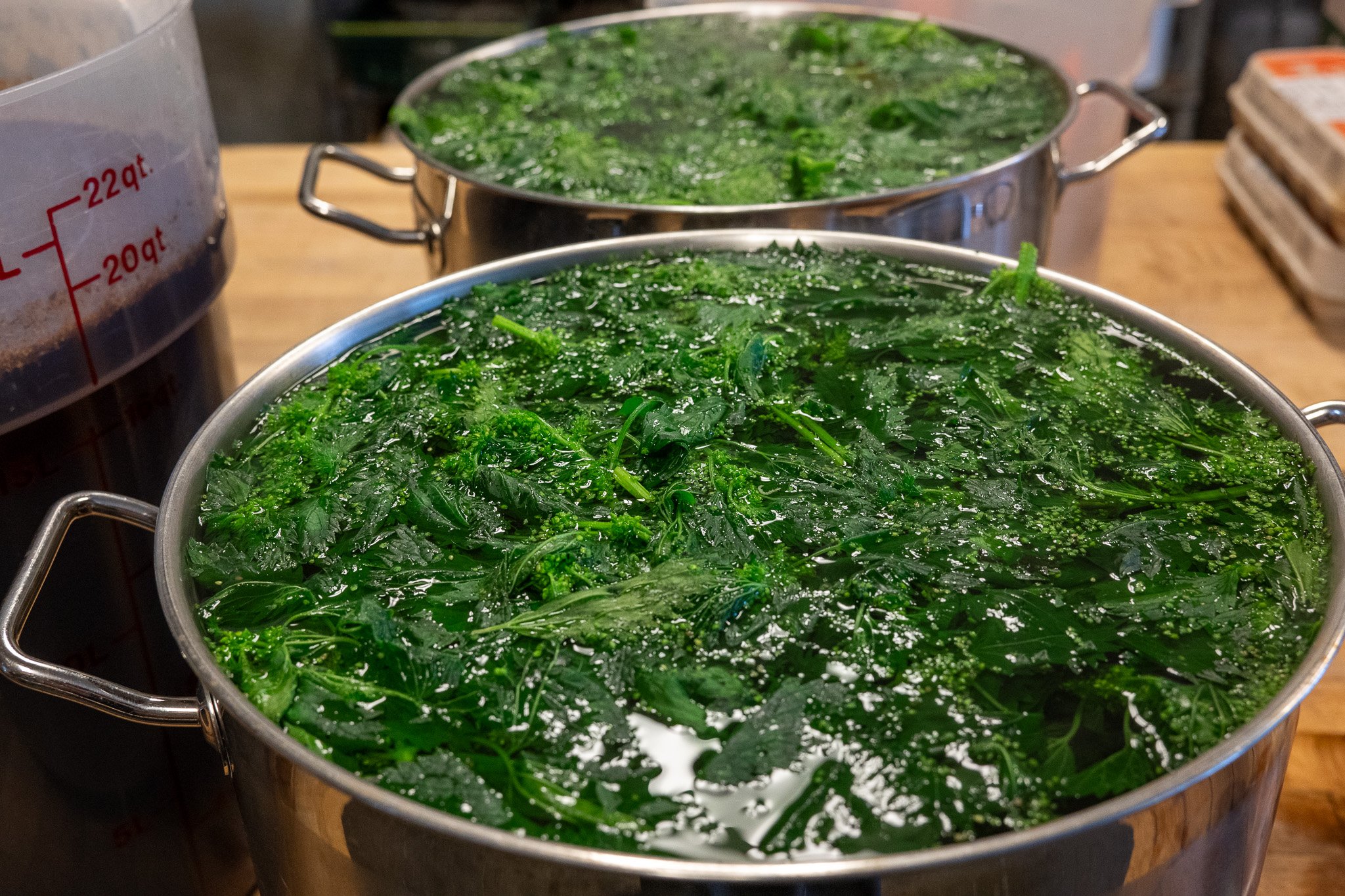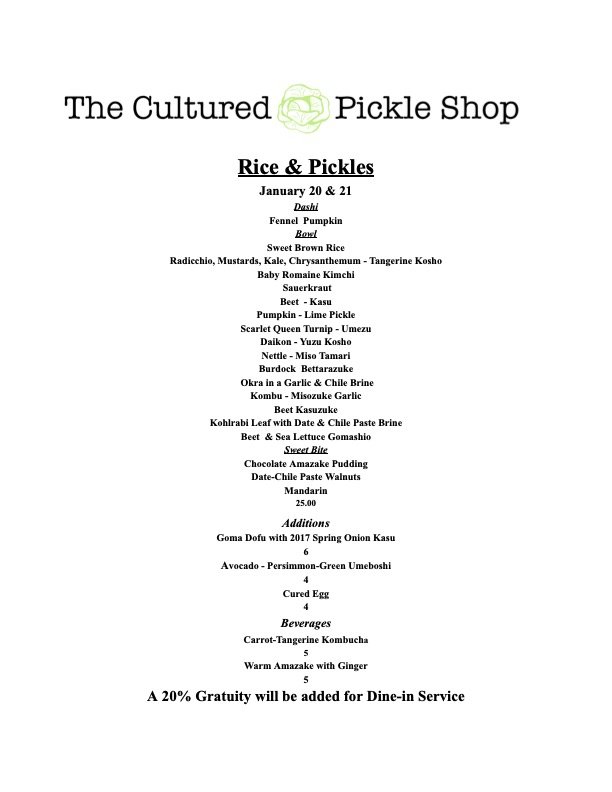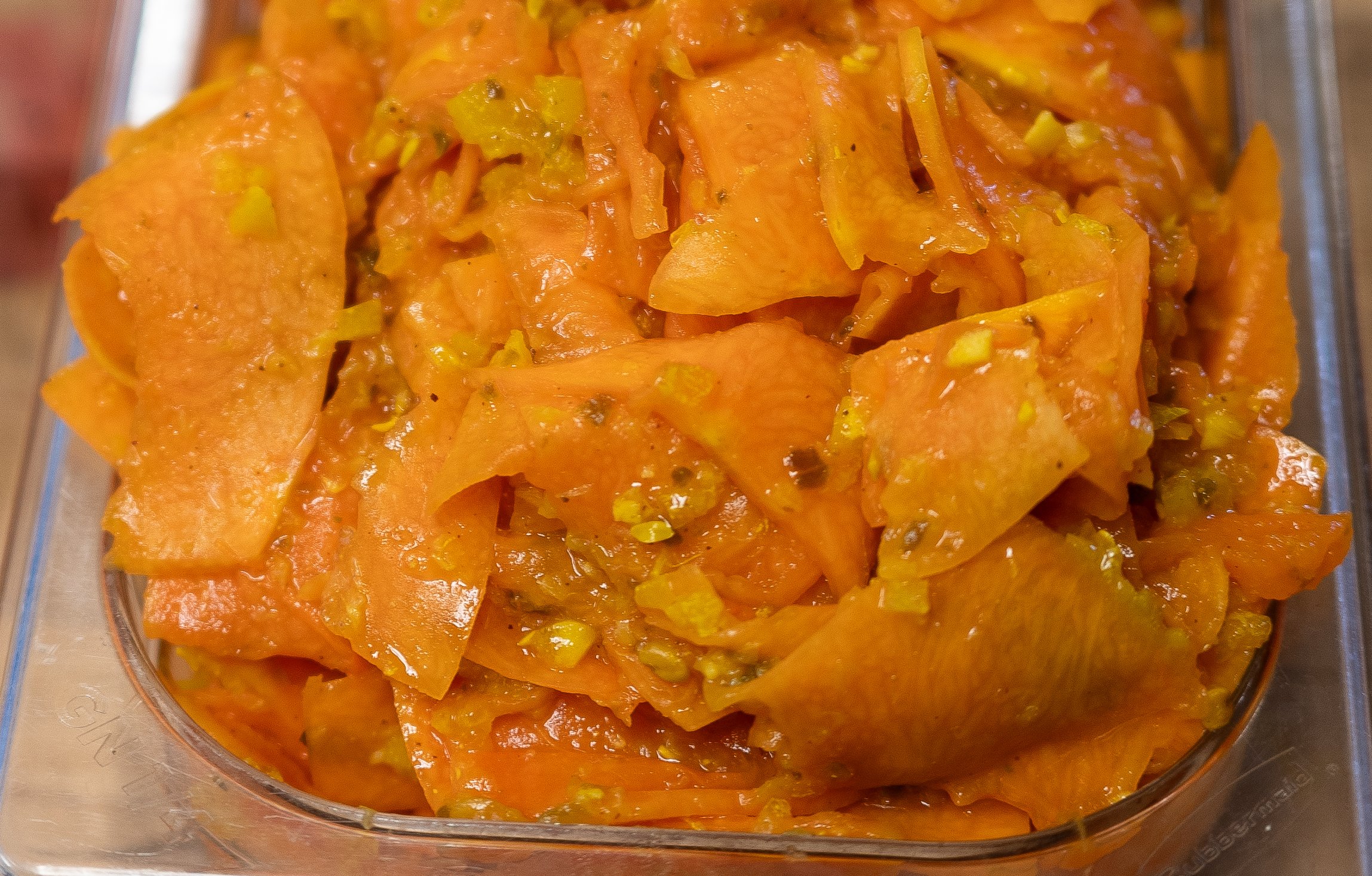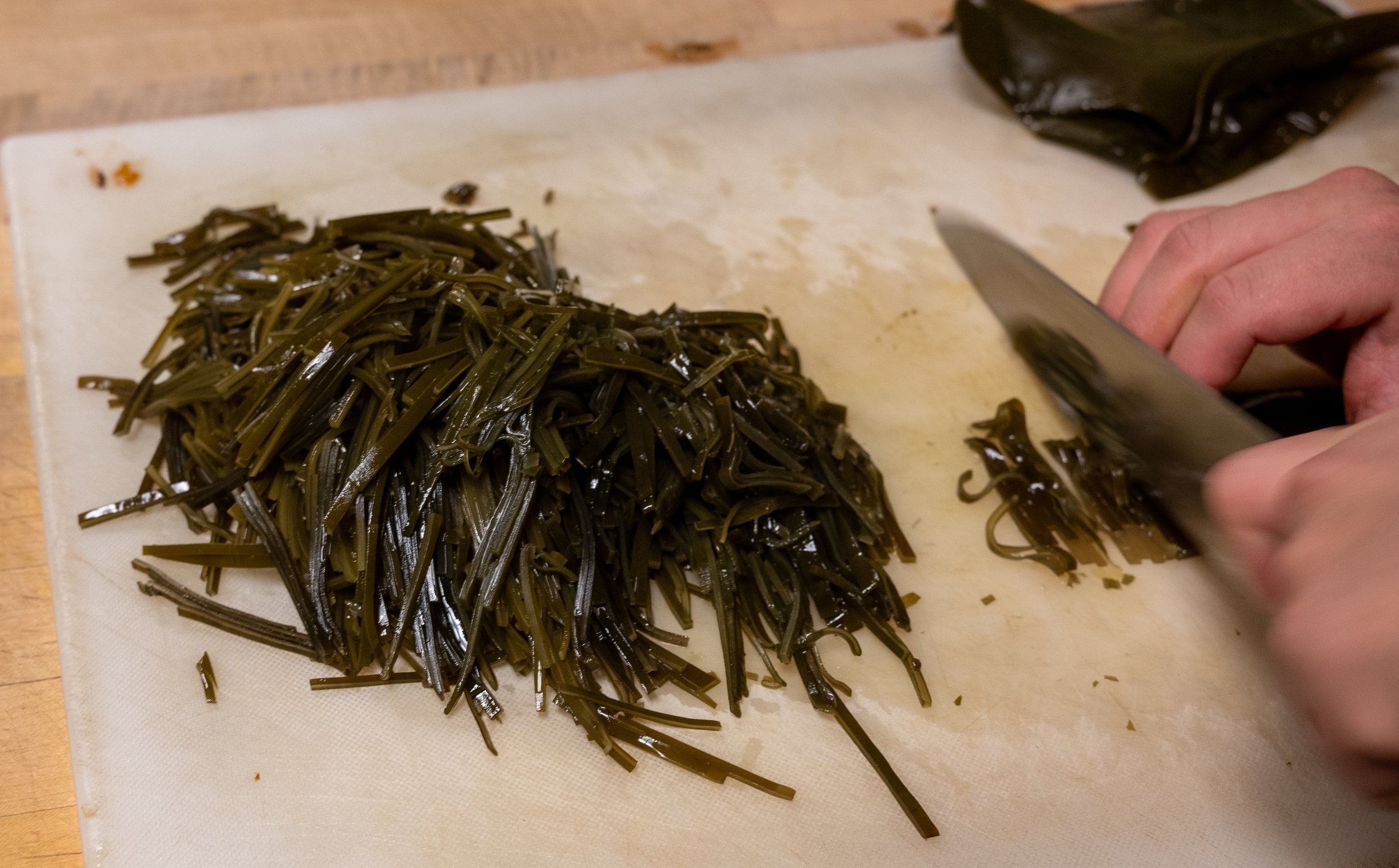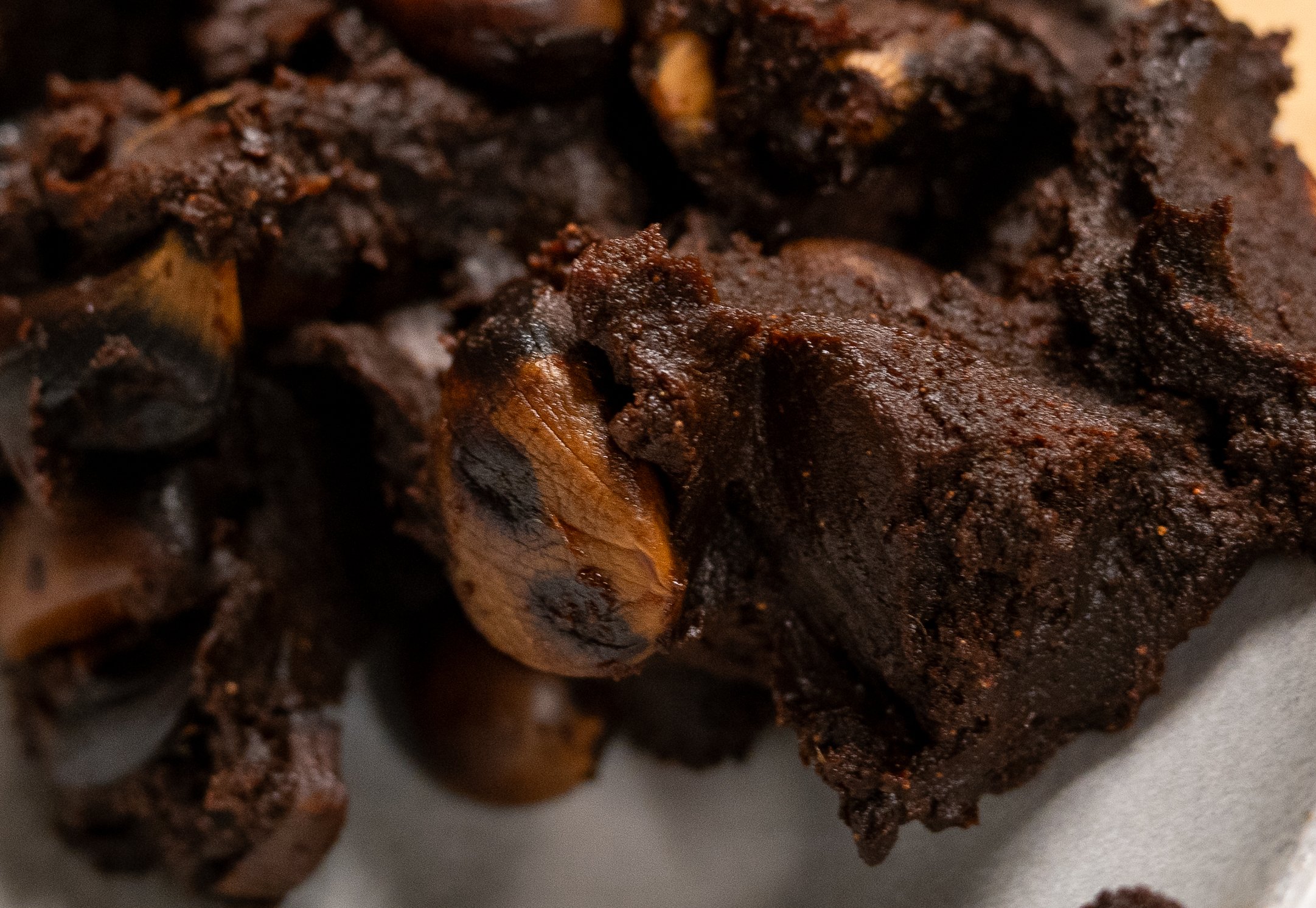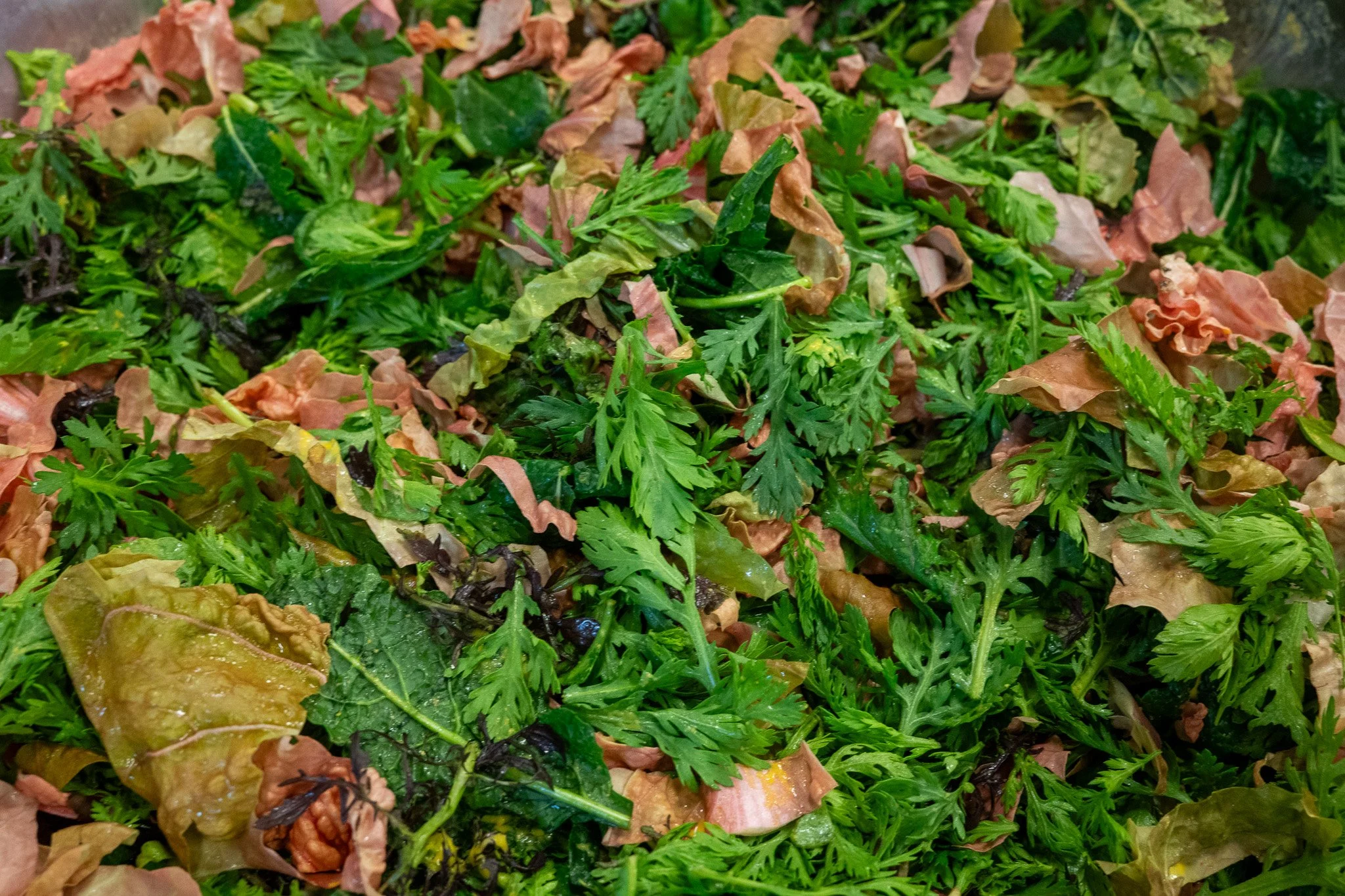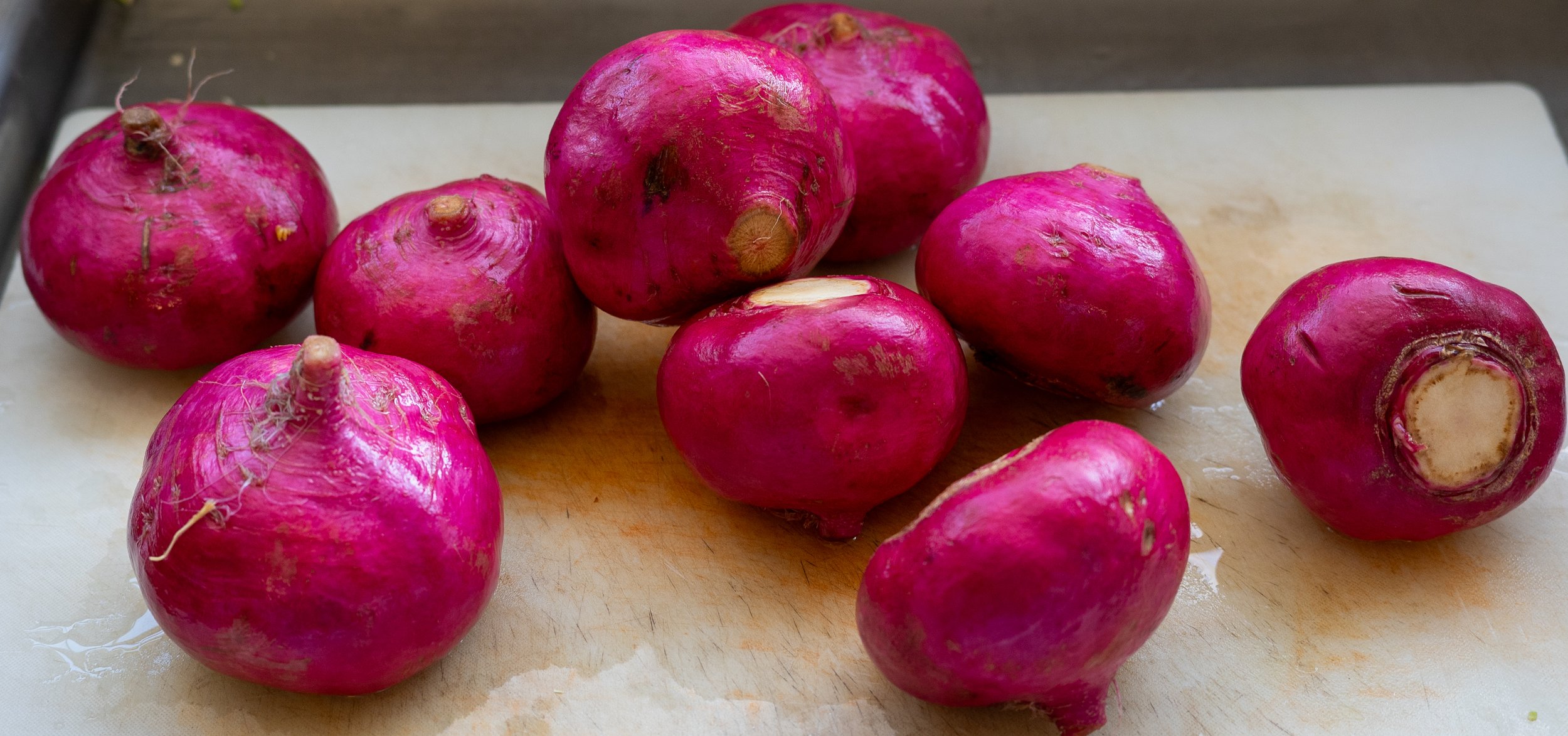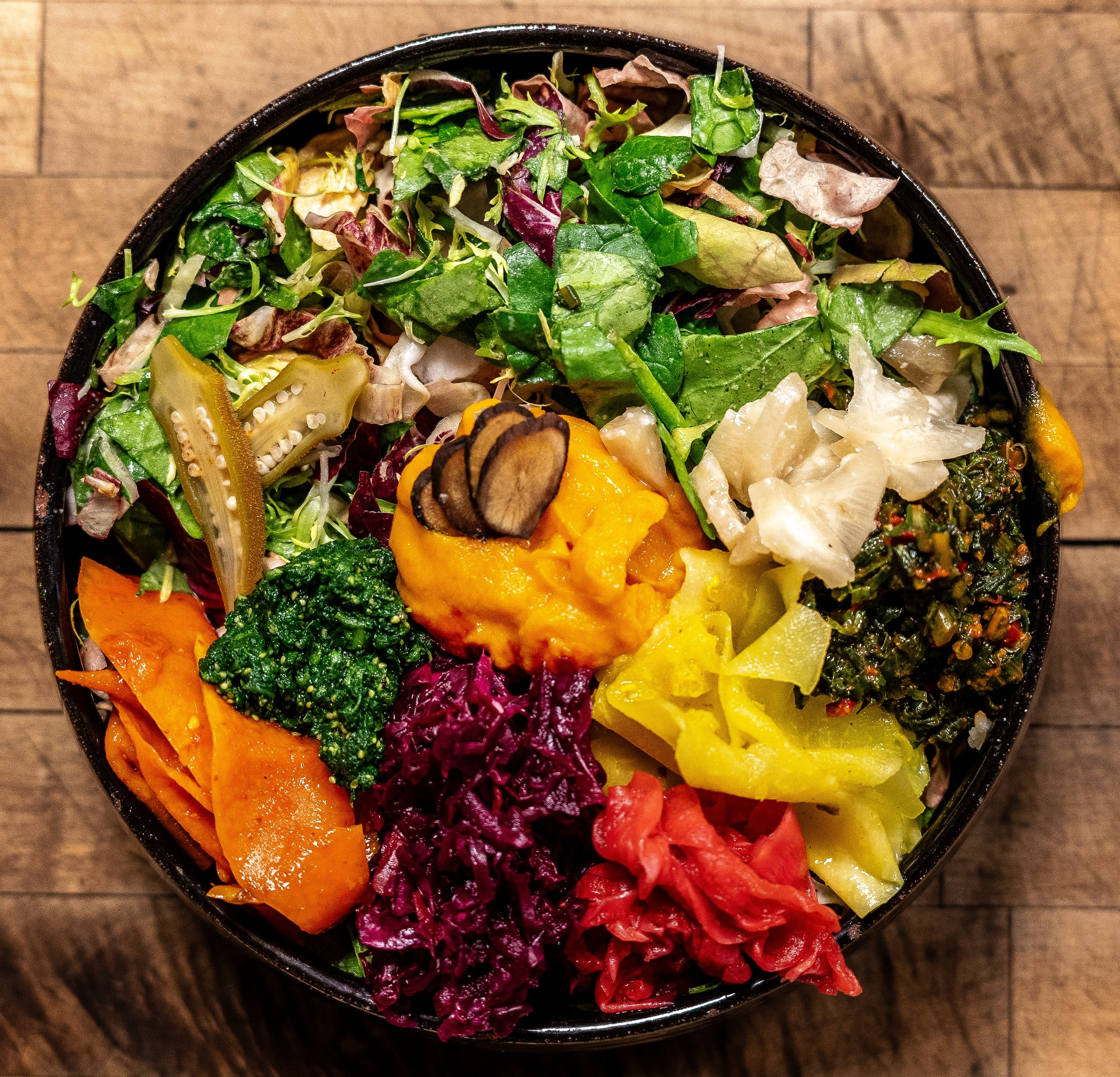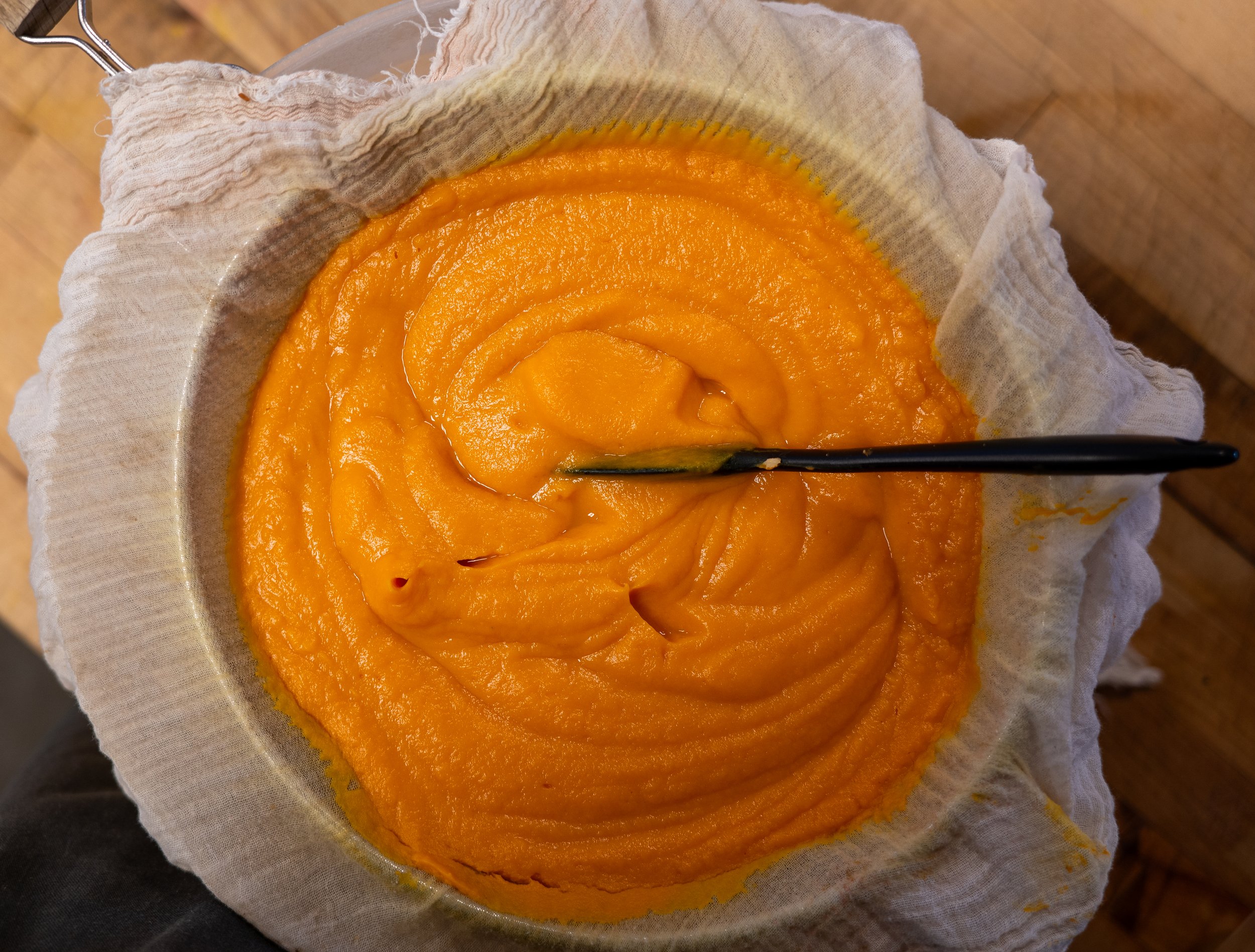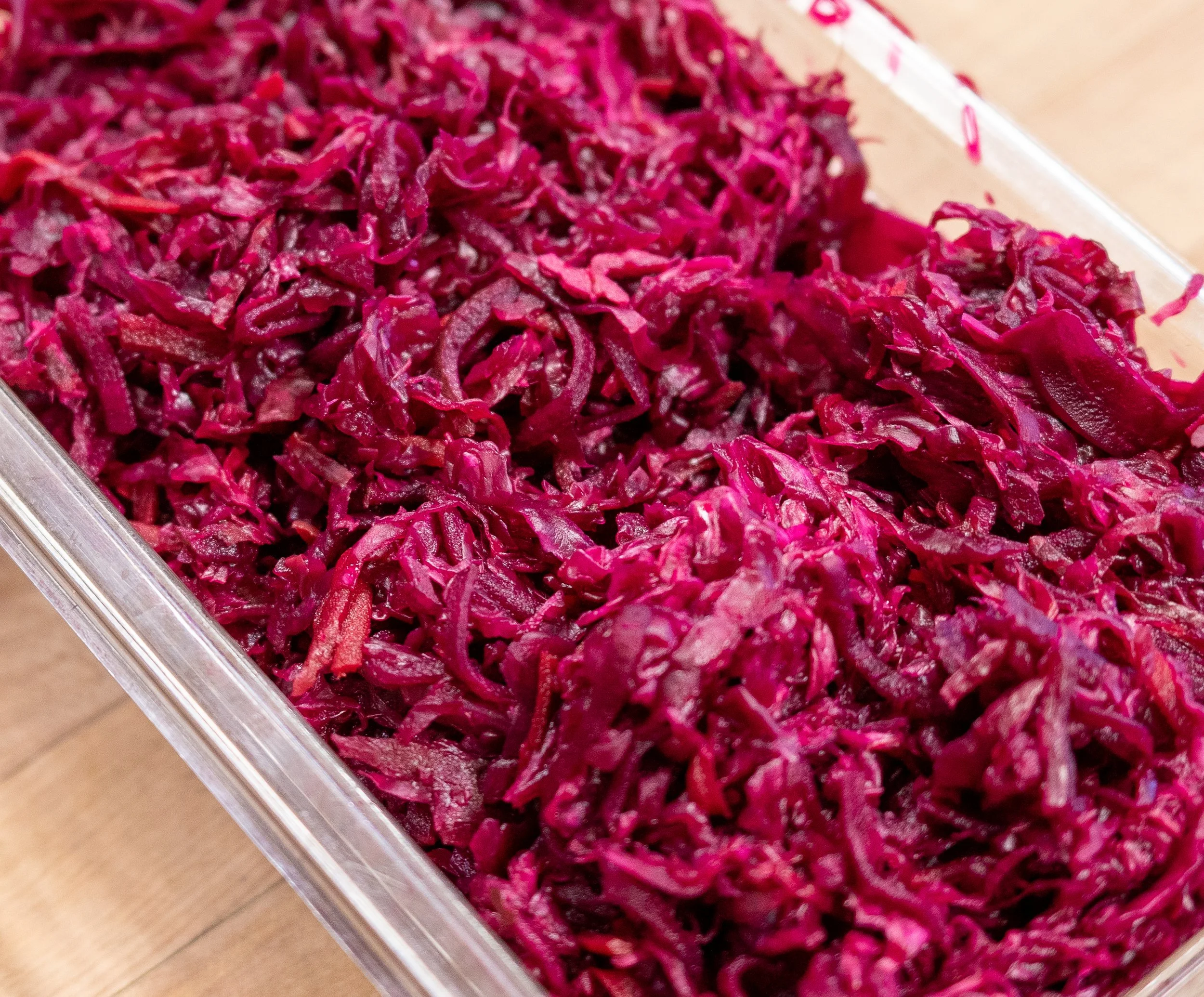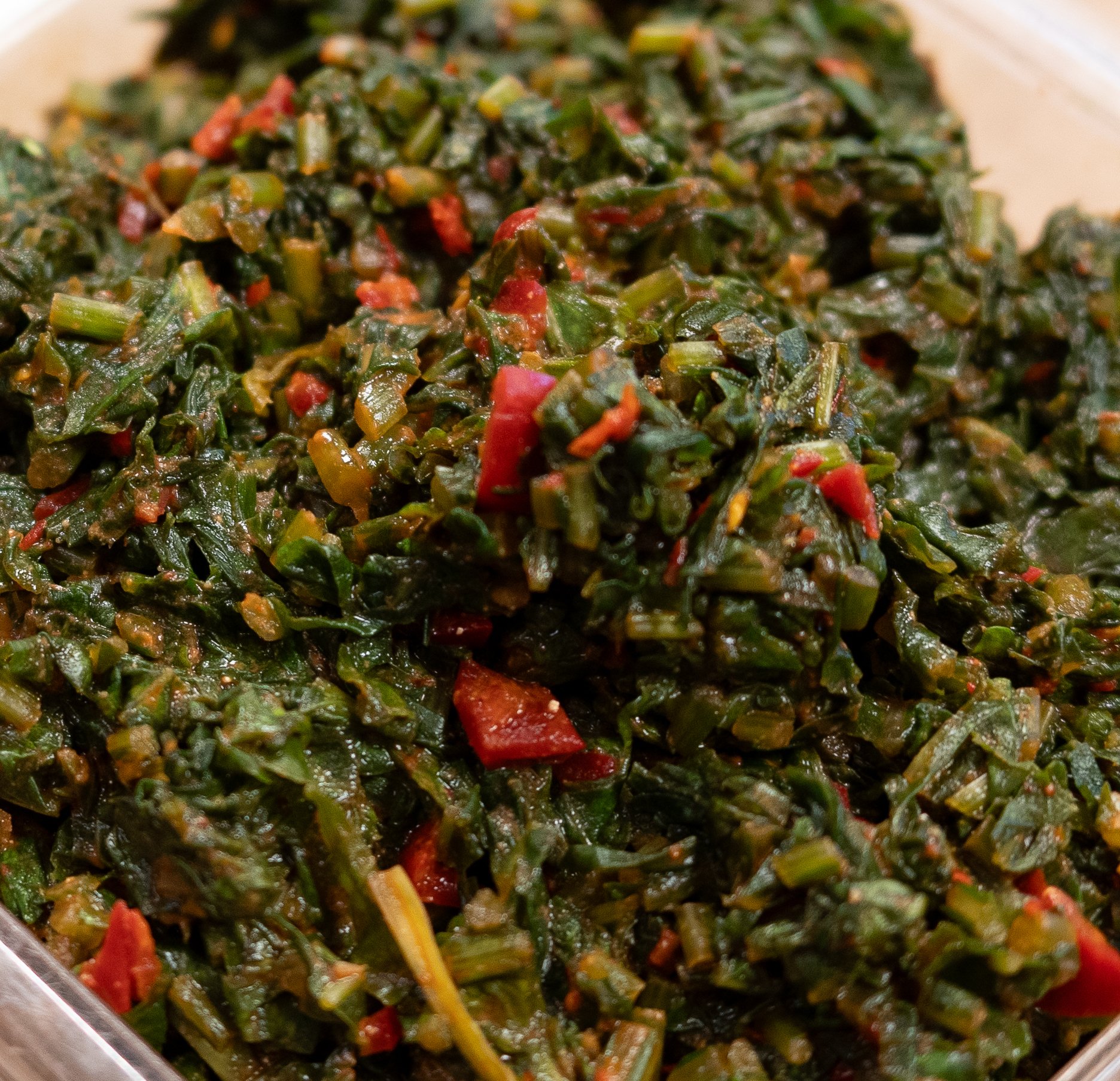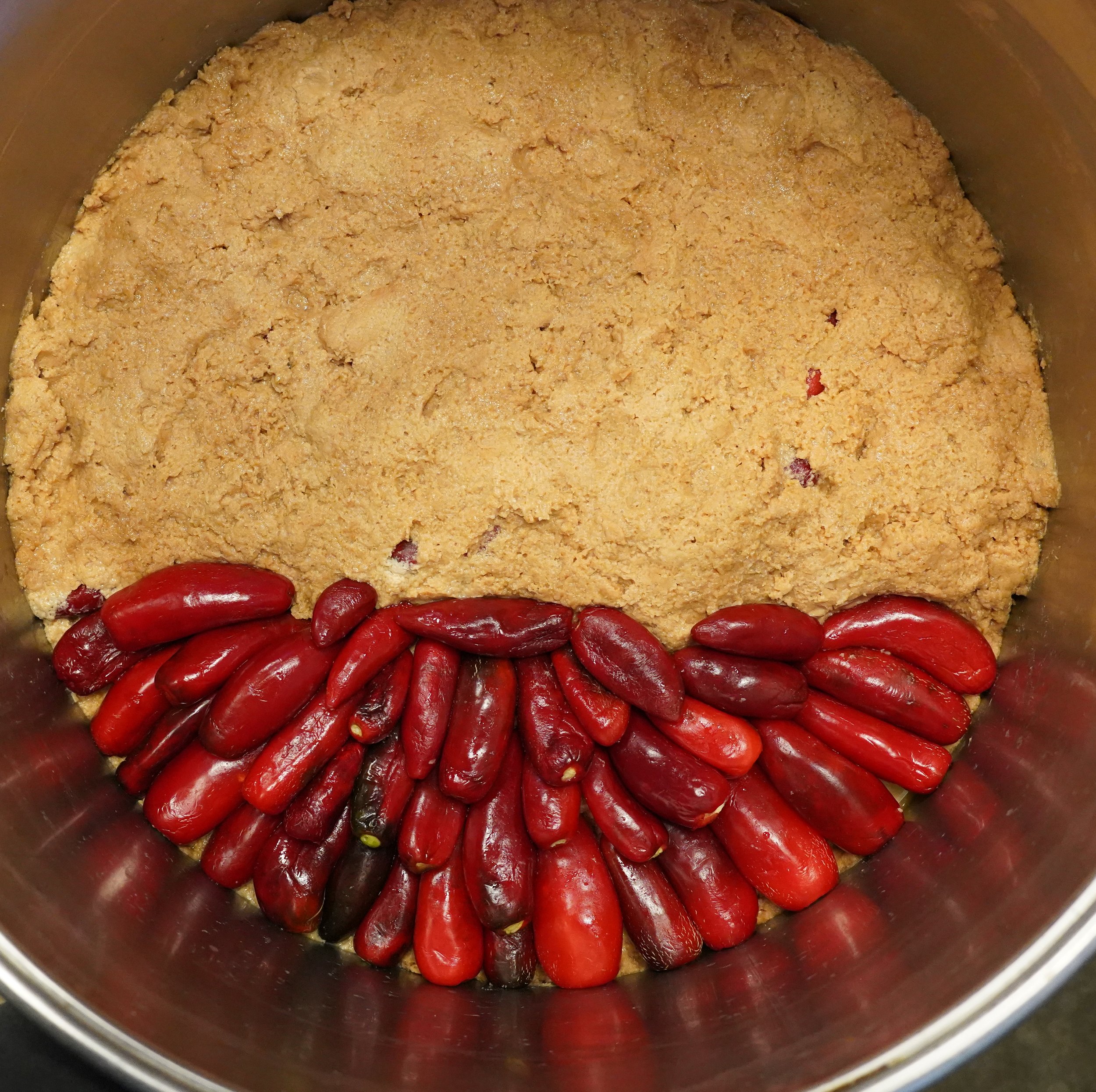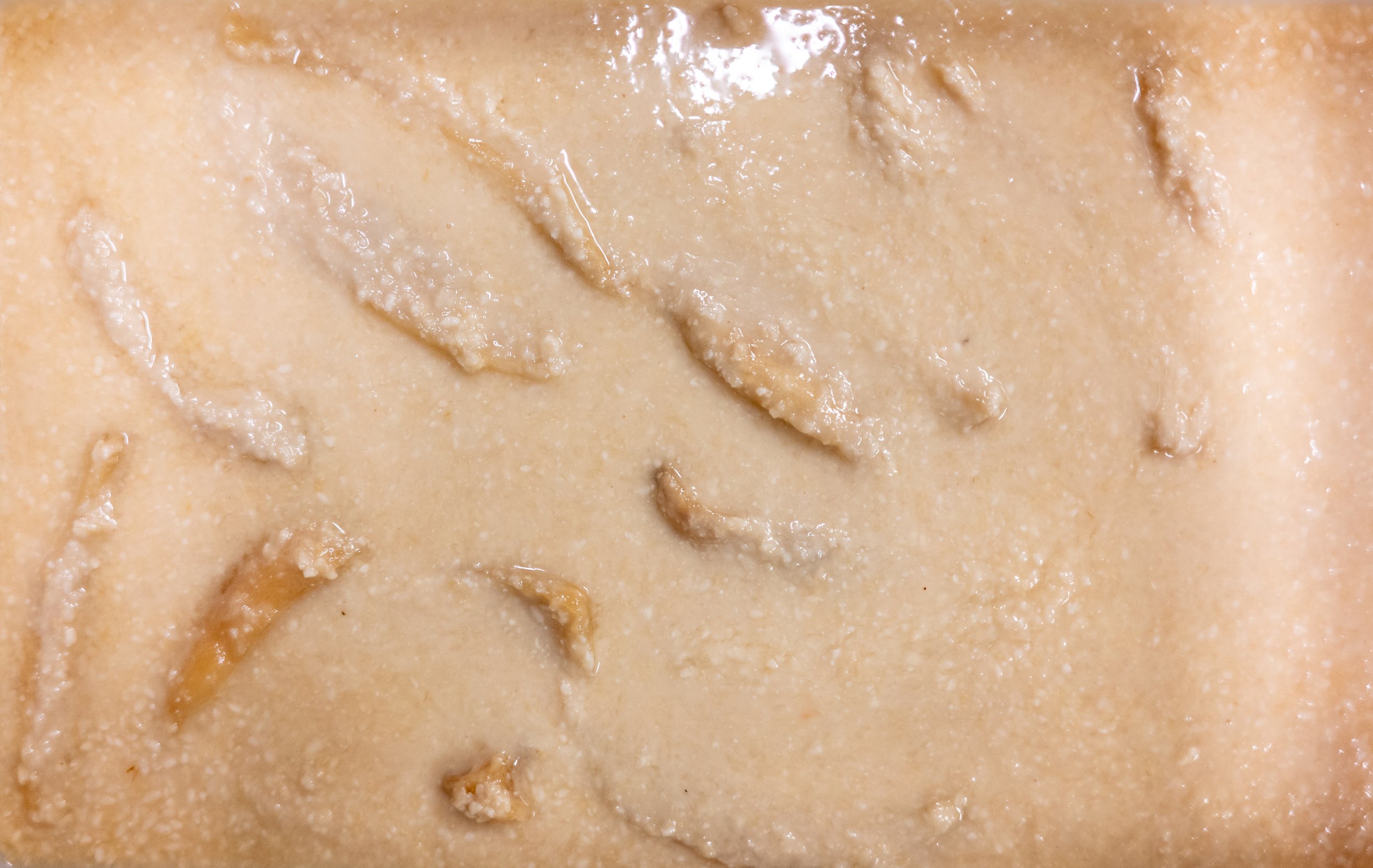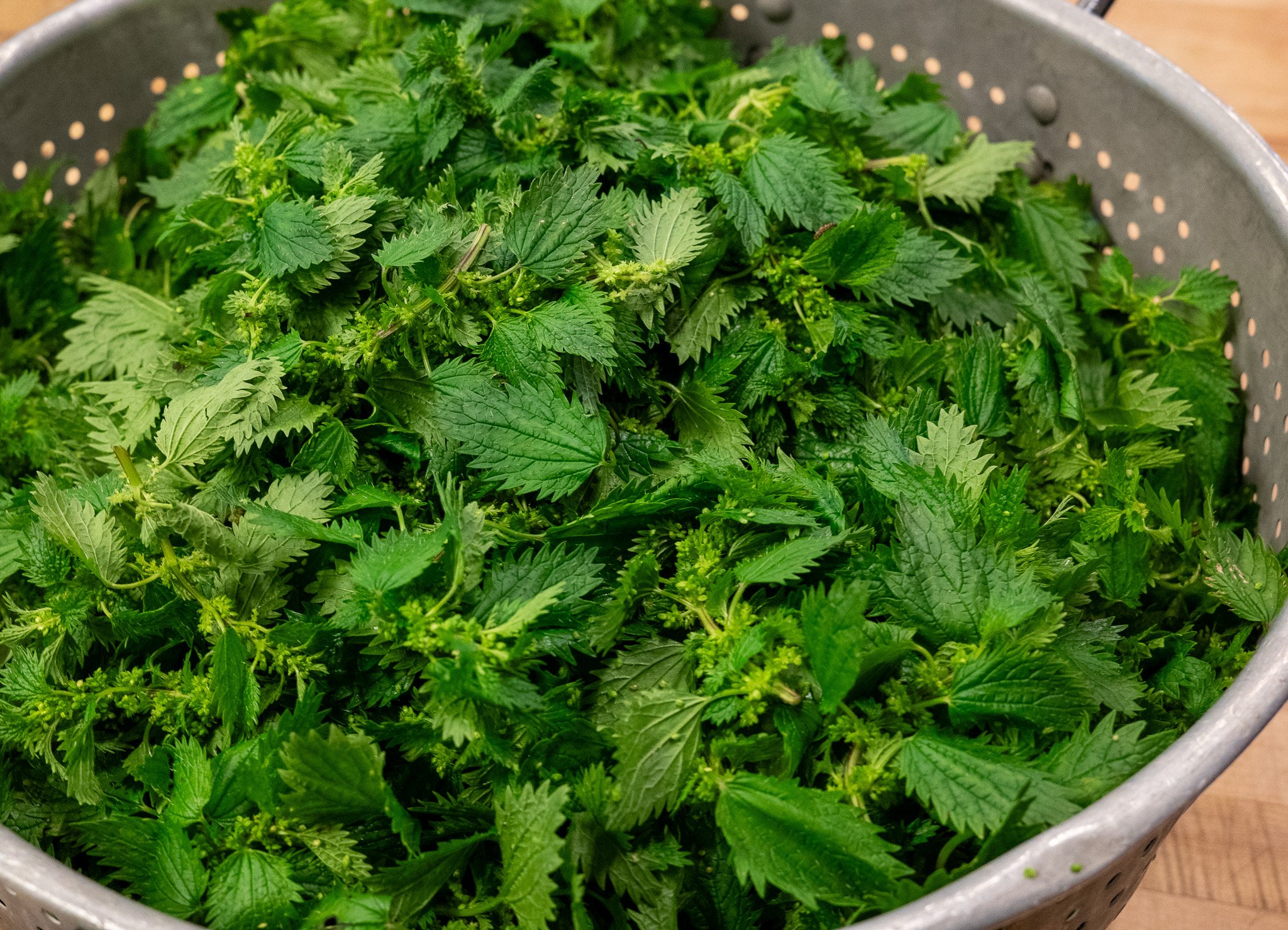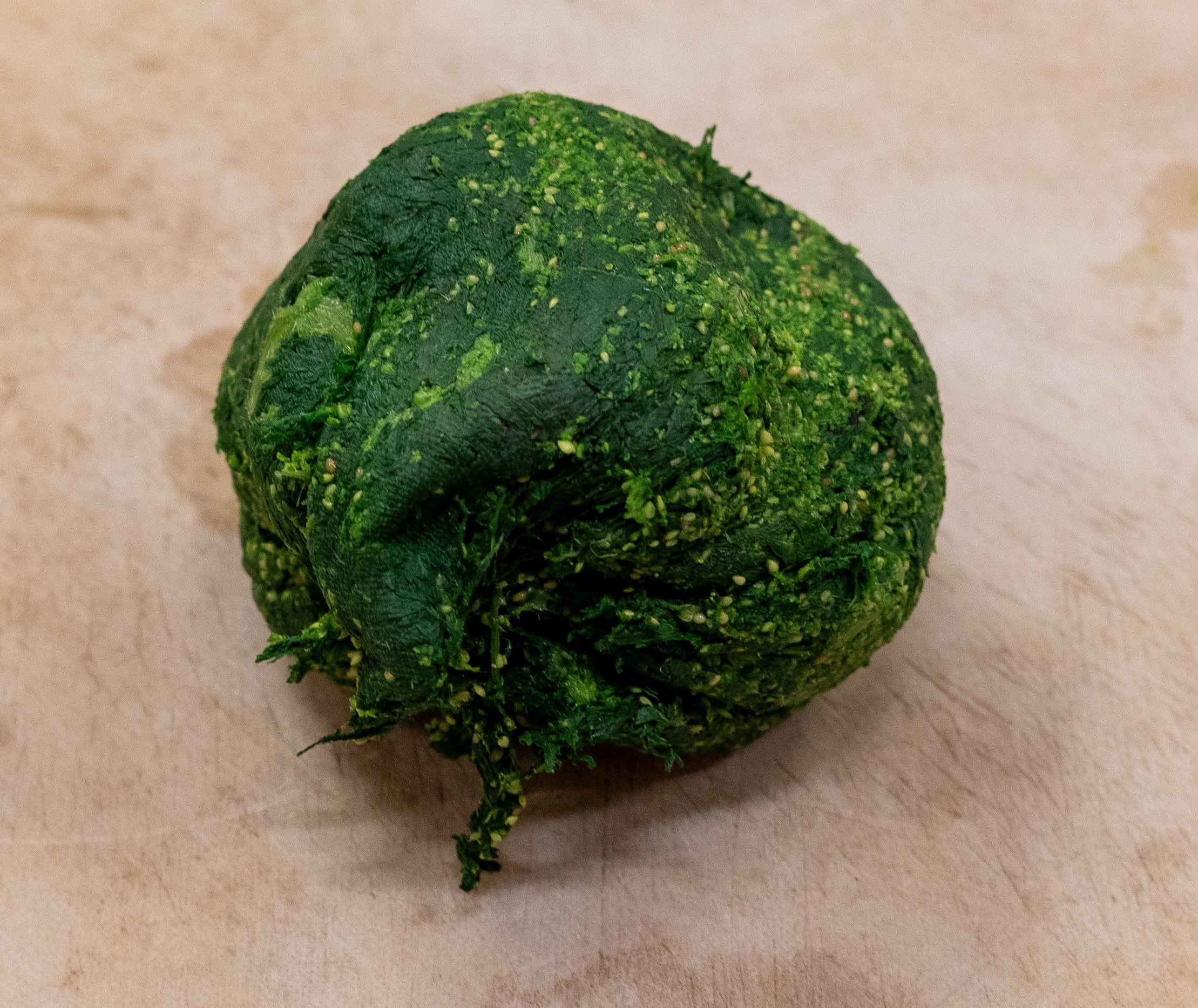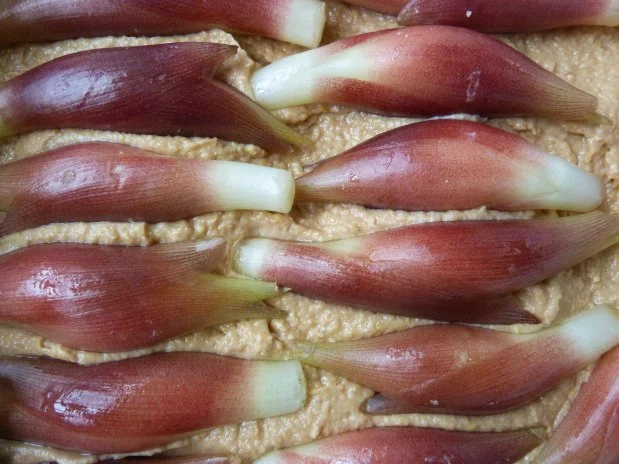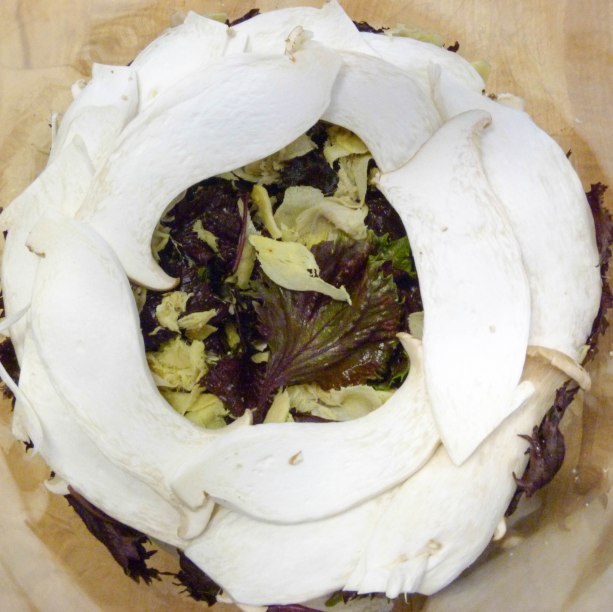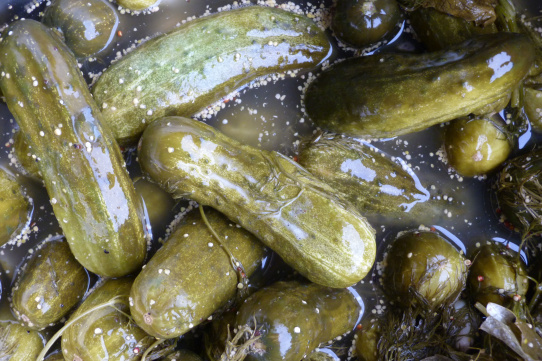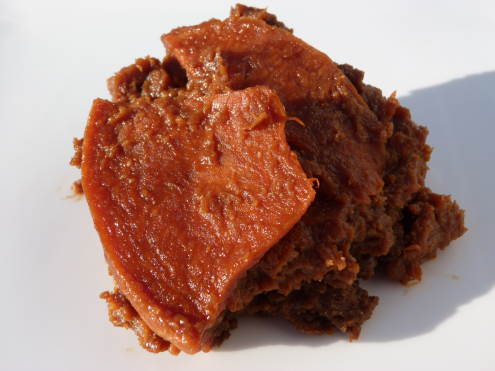Pre-Summer Round-Up
With Summer right around the corner it’s time for the blog to make its way back from an extended Spring Break. Here is a quick look at the bowls we served over the last couple of months.
Rice & Pickles March 23 & 24
Rice & Pickle April 6 & 7
Rice & Pickles April 13 & 14
Rice & Pickles April 19 & 20
Rice & Pickles April 27 & 28
Rice & Pickles May 4 & 5
Rice & Pickles May 18 & 19
Rice & Pickles May 25 & 26
Rice & Pickles June 1 & 2
Rice & Pickles June 8 & 9
Vernal Dispatch: Home
It is undeniably Spring as I write from the work table in our bedroom cottage, nestled in the middle of the back garden at our home in Berkeley. The day is glorious, and I’m a little taken aback by how far into the season we suddenly are. New culms of the timber bamboo, Bambusa oldhamii, now in its 24th year, some over four inches in diameter are coated in a glaucous powder and reach skyward for almost 35 feet. The Tree Dandelion, Sonchus canariensis, has bloomed already, producing plumes of what will be, woefully little viable seed. The branches of the Japanese Maple, Kinran, bend as they adjust to the new weight of new leaves woven with golden thread.
Seeds from the Canary Island Tree Dandelion
Acer palmatum “Kinran” transl.- ”Woven with Golden Thread”
New foliage of Lions Head Maple with Salvia Buccananni in the backround.
Sprays of pink blooms from Salvia buchananii dapple the background of the almost key lime emergence of the Lions Head maple, a specimen of unknown providence but which is certainly older than we are. Lilies- Calla, Canna, and Crinum alike unfurl, and flower, and foliate. Everywhere, Spring consumes the available space, and one has to look to see the last vestiges of winter’s husk sloughing off.
Calla Lilly “Green Goodess”
Canna Lilly
Canna Lilly Seeds
The vegetable garden, in late again, is beginning to take shape and holds some promise in the season's warmer and longer days. We may have a proper showing if we can get some growth in before the summer turns cold and foggy.
The Dogs, now solidly in their fifth year, laze about in the sun, then shade, then again in the shade, then sun- they patrol the paths, vigilantly stand sentry for squirrels, hope, pray, beg for a brief ball interlude-
or they unsettle the ducks.
Sadie
Shio
The ducks, all four of them, two in their second year and two in their sixth, can be heard at this moment furiously flapping in their small pond just around the corner from where I sit and write. After a winter of freeloading, they have all begun laying again- So they may stay.
(from left to right) Ophelia, Frances, Iris, Josephine.
A few days of duck eggs
At The Shop, now entering its 28th year, the era of Rice and Pickles has reigned on for eight years. But here, at home in a 100 year old house and in the gardens 24th year, these years will surley be known as the Dog & Duck years.
Talansias and Finials
I suppose it is in the nature of schedules to be a zero-sum game. Mine certainly is. Spring consumes not just space but time- Energy, to be sure. It is Spring! The Blog is on Spring Break.
Back soon,
Kevin
Rice & Pickles March 16 & 17
You can click on any of components of the bowl above to identify them. Scroll down for more detail.
When you Dine in with us everything from the Dashi to the Sweet Bite is included in the meal. So, the only decisions you’ll need to make are the additions. We have
Goma Dofu, which translates to Sesame Tofu. Goma Dofu is not a true tofu, in that there is no soy in it. It is made entirely out of Sesame Seeds, which are toasted, ground, pureed with some Dashi, and then heated with Kudzu Root. Kudzu Root is a root starch that acts as a binder and lends a texture to the finished product that is similar to a silken tofu, which is where it gets its name. We also have avocado. The avocados this week are Fuertes; we top them with fuyu persimmon puréed with young green Umeboshi. We also offer a cured egg. We make the eggs every Wednesday. They are a six-and-a-half minute egg that we marinate in a mixture of tamari and shiso vinegar, which is a shiso kombucha that has gone to acetic, or vinegary, to use a beverage, but the shiso flavors are still nice and clean, so we long age it into a mild vinegar mix it with the tamari and sake lees from last years Kabocha squash ferment.
Cured Eggs
We always begin the bowl with a 50/50 blend of short-grain brown and sweet brown rice, sticky or glutinous brown rice, grown by the Lundberg Family here in California. We cook our rice in a Donabe. Donabe are a family of Japanese clay cooking vessels. The Donabe we use is called a Kamado-san and is specifically designed as a rice cooker. Our Donabe comes from Iga, Japan, and has been made by the Nagatani-en family for 5 generations. Iga is a great location for Donabe making because the clay body that is found in and around Iga has a high microscopic fossil content, which results in superior heat retention in the clay products that come out of the area; so, not only is the Donabe a beautiful and effective rice cooker but it also acts a warmer as it's very slow to cool once it has come off of the flame. We top the rice with a gomashio or sesame salt. Our take on this traditional Japanese toasted sesame and salt condiment is that instead of using salt, we use either one of our ferments that we have dried and powdered or a seaweed. Today, we have toasted sesame seeds and dried and powdered beet pulp left over from juicing beets for kombucha, which gives it color, and we use Sea Lettuce instead of salt.
Donabe cooked Rice
Beets Pureed with Kasu
The Beets were steamed, pureed and seasoned with Sakle Lees, the solids that are flitered out at the end of the sake making process, a paste of rice & yeast called Kasu or Sake Kasu; that had beets fermenting in it last year.
Beet Puree
Beet Kasuzuke. The lees from this ferment were used to season the steamed beet puree.
Carrots Fermented with Dulse & Green Garlic
The Carrots are cut into ribbons and fermented with Dulse, which is a red Seaweed from the Atlantic, and Green Garlic.
Daikon Bettarazuke
We start by peeling and cutting the daikon into wedges. The peels are dried for kiriboshi and the wedges are dried for few days. Meanwhile, we make a mash made from rice, rice koji, and barley shochu; we put the dried and salted daikon in the mash and let it ferment for about a week.
Beet Green Kimchi
Sea Kraut
A Green Cabbage Sauerkraut made with Gold Beets, Burdock, Ginger and three types Seaweed; Arame, Dulse & Hijiki.
Spinach with Jalapeno Kasuzuke
Spinach was mixed with Jalapenos Fermented in Sake Lees for over a year- Jalapeno Kauzuke . Takara Sake, one of the larger sake producers in our region, is just a few blocks from The Shop. We essentially tap into their waste stream; we get the byproduct from their fermentation, a paste made up of rice, rice koji, and yeast. We take that paste, called kasu or sake kasu, and we add sugar to it to feed the yeast that is still living in it; we add salt to it to moderate the fermentation and for texture preservation, and then we bury vegetables, such as Jalapenos, in it for an average of 12-18 months to make the pickle known as kasuzuke which means pickled in kasu. This week we took the jalapeno Kasuzuke, mincied the jalapenos and mixed them with the spinach.
Red Daikon with Indian Pickled Lime
Red Daikon mixed this week with our Indian Pickled Limes - an 11-month fermentation of limes; they are our version of an Indian achar, like the mango pickle you might get on the side of your dosa. The limes are minced, mixed with the Red Daikon, and left to sit for a few days
Rice & Pickles March 9 & 10
You can click on any of components of the bowl above to identify them. Scroll down for more detail.
When you Dine in with us everything from the Dashi to the Sweet Bite is included in the meal. So, the only decisions you’ll need to make are the additions. We have
Goma Dofu, which translates to Sesame Tofu. Goma Dofu is not a true tofu, in that there is no soy in it. It is made entirely out of Sesame Seeds, which are toasted, ground, pureed with some Dashi, and then heated with Kudzu Root. Kudzu Root is a root starch that acts as a binder and lends a texture to the finished product that is similar to a silken tofu, which is where it gets its name. We also have avocado. The avocados this week are Hass from Brokaw Farm; we top them with Meyer Lemon Kosho and pickled Shiso from our Umeboshi. We also offer a cured egg. We make the eggs every Wednesday. They are a six-and-a-half minute egg that we marinate in a mixture of tamari and shiso vinegar, which is a shiso kombucha that has gone to acetic, or vinegary, to use a beverage, but the shiso flavors are still nice and clean, so we long age it into a mild vinegar mix it with the tamari and sake lees from last years Kabocha squash ferment.
We always begin the bowl with a 50/50 blend of short-grain brown and sweet brown rice, sticky or glutinous brown rice, grown by the Lundberg Family here in California. We cook our rice in a Donabe. Donabe are a family of Japanese clay cooking vessels. The Donabe we use is called a Kamado-san and is specifically designed as a rice cooker. Our Donabe comes from Iga, Japan, and has been made by the Nagatani-en family for 5 generations. Iga is a great location for Donabe making because the clay body that is found in and around Iga has a high microscopic fossil content, which results in superior heat retention in the clay products that come out of the area; so, not only is the Donabe a beautiful and effective rice cooker but it also acts a warmer as it's very slow to cool once it has come off of the flame. We top the rice with a gomashio or sesame salt. Our take on this traditional Japanese toasted sesame and salt condiment is that instead of using salt, we use either one of our ferments that we have dried and powdered or a seaweed. Today, we have toasted sesame seeds and dried and powdered beet pulp left over from juicing beets for kombucha, which gives it color, and we use Sea Lettuce instead of salt.
Parsnip steamed and pureed with a Sweet White Miso that we make at the shop.
Steamed Parsnip
Parsnip Puree seasoned with our Sweet White Miso
Spinach with Jalapeno Kasuzuke
Takara Sake, one of the larger sake producers in our region, is just a few blocks from The Shop. We essentially tap into their waste stream; we get the byproduct from their fermentation, a paste made up of rice, rice koji, and yeast. We take that paste, called kasu or sake kasu, and we add sugar to it to feed the yeast that is still living in it; we add salt to it to moderate the fermentation and for texture preservation, and then we bury vegetables, such as Jalapenos, in it for an average of 12-18 months to make the pickle known as kasuzuke which means pickled in kasu.
Jalapenos fermented in sake lees for 12 months.
prepping jalapeno kasuzuke
Minced Kasuzuke Jalapenos and Spinach
Fennel With Indian Lime Pickle
The fennel bulb was shaved on a mandolin and mixed with our Indian Pickle Lime, which is an 11-month fermentation of limes; they are our version of an Indian achar, like the mango pickle you might get on the side of your dosa. The limes are minced, mixed with the shaved fennel, and left to sit for a few days
Mincing Indian Pickled Limes
Daikon pickled in Umezu
Umezu is the brine from Umeboshi plums also called Ume Vinegar. Daikon is shaved thin on the mandolin and pressed for two days in Umezu.
Pumpkin Kimchi
This has been a favorite Kimchi for us this year. We use a French heirloom pumpkin called a Musquee de Provence or Fairytale, it is a beautiful pumpkin with deep orange color and a subtle melon flavor.
There were two components on this weeks bowl that didn’t make it into the photo above:
Beet Green with Miso Tamari
Blanched & Shocked and mixed with miso tamari, the liquid that rises to the top of the vessel during our Sweet White Miso production
Blanched Beet Greens
Carrot Kiriboshi
Kiriboshi is dried shredded Daikon typically served as a small side dish simmered in dashi. For Kiriboshi at The Shop we use the peels from various vegetables, dry them and simmer them in broth. Last week the puree at the center of the bowl was purple carrot. We peeeled the carrrots before steaming them and reserved the peels. We dried the peels all week and then simmered them on the draining liquid from the purple carrot puree.
Purple carrot puree seasoned with nour sweet white miso. The puree sits in a strainer lined with cheese cloth and we collect any liquid that strains out.
Purple Carrot Peels
liquid collected from straining the puree
Rice & Pickles March 2 & 3
You can click on any of components of the bowl above to identify them. Scroll down for more detail.
We always begin the bowl with a 50/50 blend of short-grain brown and sweet brown rice, sticky or glutinous brown rice, grown by the Lundberg Family here in California. We cook our rice in a Donabe. Donabe are a family of Japanese clay cooking vessels. The Donabe we use is called a Kamado-san and is specifically designed as a rice cooker. Our Donabe comes from Iga, Japan, and has been made by the Nagatani-en family for 5 generations. Iga is a great location for Donabe making because the clay body that is found in and around Iga has a high microscopic fossil content, which results in superior heat retention in the clay products that come out of the area; so, not only is the Donabe a beautiful and effective rice cooker but it also acts a warmer as it's very slow to cool once it has come off of the flame. We top the rice with a gomashio or sesame salt. Our take on this traditional Japanese toasted sesame and salt condiment is that instead of using salt, we use either one of our ferments that we have dried and powdered or a seaweed. Today, we have toasted sesame seeds and dried and powdered beet pulp left over from juicing beets for kombucha, which gives it color, and we use Sea Lettuce instead of salt.
Our Sauerkraut Salad made with green cabbage fermented with Beets, Carrots and Ginger
Spinach mixed with Jalapeno Kasuzuke, a one year fermentation of jalapenos in sake lees.
Kasuzuke Jalapenos
Kohlrabi
Kohlrabi shaved on a mandolin and mixed with our Indian Pickled Limes- an 11-month fermentation of limes; they are our version of an Indian achar, like the mango pickle you might get on the side of your dosa. The limes are minced, mixed with the Kohlrabi, and left to sit for a few days
Indian Pickled Limes
Bettarazuke. A month ago, we made a mash made from rice, rice koji, and barley shochu; we put dried and salted daikon in the mash and let it ferment for about a week. That daikon appeared on the bowl last week. This week we put shaved kabocha squash into that same mash.
Carrots fermented with Dulse and Green Garlic
Daikon pickled in the Brine from our Umeboshi plums, also called Ume Vinegar or Umezu
Rice & Pickles February 10 & 11
A new feature this week. You can click on the dots on each component in the bowl and get a quick description. You can scroll down for a little more detail.
Menu
We always begin the bowl with a 50/50 blend of short-grain brown and sweet brown rice, sticky or glutinous brown rice, grown by the Lundberg Family here in California. We cook our rice in a Donabe. Donabe are a family of Japanese clay cooking vessels. The Donabe we use is called a Kamado-san and is specifically designed as a rice cooker. Our Donabe comes from Iga, Japan, and has been made by the Nagatani-en family for 5 generations. Iga is a great location for Donabe making because the clay body that is found in and around Iga has a high microscopic fossil content, which results in superior heat retention in the clay products that come out of the area; so, not only is the Donabe a beautiful and effective rice cooker but it also acts a warmer as it's very slow to cool once it has come off of the flame.
We top the rice with a gomashio or sesame salt. Our take on this traditional Japanese toasted sesame and salt condiment is that instead of using salt, we use either one of our ferments that we have dried and powdered or a seaweed. Today, we have toasted sesame seeds and dried and powdered beet pulp left over from juicing beets for kombucha, which gives it color, and we use Sea Lettuce instead of salt.
Butternut Squash, steamed, pureed and seasoned with 2022 Kabocha Kasu. Takara Sake, one of the larger sake producers in our region, is just a few blocks from The Shop. We essentially tap into their waste stream; we get the byproduct from their fermentation, a paste made up of rice, rice koji, and yeast. We take that paste, called kasu or sake kasu, and we add sugar to it to feed the yeast that is still living in it; we add salt to it to moderate the fermentation and for texture preservation, and then we bury vegetables, such as Kabocha Squash, in it for an average of 12-18 months to make the pickle known as kasuzuke which means pickled in kasu. When the kasuzuke is jarred and sold we hold on to the remaining kasu for aging. We have a whole archive of variously aged and flavored kasu going back to 2011. We use it like you would use miso; as a seasoning, as a condiment, to create a broth. Here the squash puree was seasoned with kasu from a 2022 Kabocha ferment.
Romanesco mixed this week with our Indian Pickled Limes - an 11-month fermentation of limes; they are our version of an Indian achar, like the mango pickle you might get on the side of your dosa. The limes are minced, mixed with the Romanesco, and left to sit for a few days
The Nettles were blanched, shocked, and marinated in Miso Tamari, the liquid that rises to the top of the vessel during our sweet white miso production.
Rice & Pickles February 3 & 4
If you join us for Rice and Pickles on the weekend and sit at the bar across from me, I take you through the bowl as I build it, describing how each component is made. If you are a repeat guest at the bar, you’ll know that I definitely have a spiel. That spiel changes a little from week to week because the bowl changes a little from week to week. For regulars, I try to switch it up a bit. I leave some things out, give briefer descriptions, or take deeper dives into one or two components. This recap of the Rice & Pickles Bowl will essentially be my weekly recitation told as if there is a combination of regulars and newcomers at the bar.
Menu
When you Dine in with us everything from the Dashi to the Sweet Bite is included in the meal. So, the only decisions you’ll need to make are the additions. We have
Goma Dofu, which translates to Sesame Tofu. Goma Dofu is not a true tofu, in that there is no soy in it. It is made entirely out of Sesame Seeds, which are toasted, ground, pureed with some Dashi, and then heated with Kudzu Root. Kudzu Root is a root starch that acts as a binder and lends a texture to the finished product that is similar to a silken tofu, which is where it gets its name. We also have avocado. The avocados this week are Fuertes; we top them with fuyu persimmon puréed with young green Umeboshi. We also offer a cured egg. We make the eggs every Wednesday. They are a six-and-a-half minute egg that we marinate in a mixture of tamari and shiso vinegar, which is a shiso kombucha that has gone to acetic, or vinegary, to use a beverage, but the shiso flavors are still nice and clean, so we long age it into a mild vinegar mix it with the tamari and sake lees from last years Kabocha squash ferment.
Donabe
We always begin the bowl with a 50/50 blend of short-grain brown and sweet brown rice, sticky or glutinous brown rice, grown by the Lundberg Family here in California. We cook our rice in a Donabe. Donabe are a family of Japanese clay cooking vessels. The Donabe we use is called a Kamado-san and is specifically designed as a rice cooker. Our Donabe comes from Iga, Japan, and has been made by the Nagatani-en family for 5 generations. Iga is a great location for Donabe making because the clay body that is found in and around Iga has a high microscopic fossil content, which results in superior heat retention in the clay products that come out of the area; so, not only is the Donabe a beautiful and effective rice cooker but it also acts a warmer as it's very slow to cool once it has come off of the flame. We top the rice with a gomashio or sesame salt. Our take on this traditional Japanese toasted sesame and salt condiment is that instead of using salt, we use either one of our ferments that we have dried and powdered or a seaweed. Today, we have toasted sesame seeds and dried and powdered beet pulp left over from juicing beets for kombucha, which gives it color, and we use Sea Lettuce instead of salt.
Beet & Sea Lettuce Gomashio
In the center of the bowl, we have parsnip that is steamed, pureed, and seasoned with a sweet white miso that we make here at the shop. At the bottom center of the bowl is a classic cabbage and sea salt sauerkraut. To the right of that, we have Kohlrabi pickled in the Brine from our Umeboshi plums, also called Ume Vinegar or Umezu. The Kohlrabi is shaved on the mandoline, mixed with Umezue, and left to sit for a couple of days. Continuing to the right along the bottom of the bowl,l we have we have Bettarazuke. A couple of weeks ago, we made a mash made from rice, rice koji, and barley shochu; we put dried and salted daikon in the mash and let it ferment for about a week. Next to the Bettarazuke, we have a Kimchi of Pumpkin. Nestled in amongst the kimchi, the daikon and the kohlrabi is parsley that was plucked and marinated in miso tamari, the liquid that rises to the top of the vessel during our sweet white miso production. Finally, up at the top of the right side of the bowl, we have okra. The okra was fermented in a brine with chile and garlic.
Parsnip & White Miso
Kohrabi
Kohlrabi
Kohlrabi in Umezu
Pumpkin Kimchi
On the left side of the sauerkraut, along the bottom of the bowl, are mustard greens fermented with leeks, fresh turmeric and fennel seed. Next to the mustard greens, we have Red Daikon mixed this week with our Indian Pickled Limes - an 11-month fermentation of limes; they are our version of an Indian achar, like the mango pickle you might get on the side of your dosa. The limes are minced, mixed with the Red Daikon, and left to sit for a few days. Next to the red Daikon is Kombu with Misozuke Garlic. On Tuesday, we took the Kombu from last week's dashi, julienned it, and mixed it with Misozuke Garlic. The garlic is a young garlic harvested in June of 2022 and buried in a Hatcho miso, where it has been fermenting ever since. The garlic and the miso are minced together and mixed with the kombu.
Red Daikon with Indian Picklede Lime
Misozuke Garlc
Above the Parsnip puree, we have slices of Beet. The beets were fermented in sake lees for two years- Kauzuke Beetsl. Takara Sake, one of the larger sake producers in our region, is just a few blocks from The Shop. We essentially tap into their waste stream; we get the byproduct from their fermentation, a paste made up of rice, rice koji, and yeast. We take that paste, called kasu or sake kasu, and we add sugar to it to feed the yeast that is still living in it; we add salt to it to moderate the fermentation and for texture preservation, and then we bury vegetables, such as Beets, in it for an average of 12-18 months to make the pickle known as kasuzuke which means pickled in kasu. Today's greens are a mix of Frisee and Mustards. They are dressed with a fermented yuzu rind or a Kosho. Kosho is traditionally made with yuzu rind. We make ours with a variety of California citrus. We took the rind from the yuzu, pureed it with salt, and fermented it for about a week. We then took that fermented citrus paste and thinned it with olive oil and yuzu juice to make a salad dressing. Finally, we add a Scallion crisp on top of the puree. The Scallion was rubbed with a paste we make from dates, tamari, and the brine from our chile paste and dehydrated.
Beet Kasuzuke
Frisee & Mustards
Scallion rubbed with Date & Chile Paste
The Week in Review January 29-February 2
Tuesday
Kombucha. Prep & Packing.
We Juiced Celery and Yuzu and added the juice to a fermented Sencha, green tea, for Kombucha.
Celery for Kombucha
Yuzu for Kombucha
Celery-Yuzu Kombucha
We prepped Fennel for Kasuzuke. For this project, we use only the fennel bulb. We remove the stems and reserve them for juicing. The bulbs are quartered and salted at 6%. We will press the salted bulbs for two days before burying them in the lees.
Fennel for Kasuzuke
Fennel stems for juicing
Fennel salted at 6% for Kasuzuke
Alex packed some Sea Kraut. This is one of my favorite varieties of sauerkraut that we produce. It is a Green Cabbage Sauerkraut with Gold Beets, Burdock, Ginger, and three types of seaweed- Arame Dulse & Hijiki.
Sea Kraut
Wednesday
Kimchi. Kombucha
Mint SCOBY
We juiced Fennel and Apple and added the juice to a fermented Mint tea. We juiced both the bulbs and the stems of the fennel and saved the fronds and the pulp for the weekend's Dashi.
Apples for Kombucha
Fennel and Apple Juice for Kombucha
Fennel-Apple-Mint Kombucha
We worked on two Kimchis. Bok Choy, which had been brining for two days, was drained and dried for the day. It was mixed with Dulse, Ginger, Garlic and Chile in the evening. We laboriously cubed daikon to be brined for the next two days.
Bok Choy with Ginger and Dulse for Kimchi
Daikon
Daikon cubed for Kimchi
Parsley leaves were plucked to be marinated in Miso Tamari. The stems were saved for the weekend's Dashi.
Parsley to be marinated in Miso Tamari
A batch of Ginger & Turmeric Carrots was packaged. For most of our lacto-fermented pickles, we coax a brine out of the vegetables by salting them and allowing the salt to pull the liquid out, forming a brine of the vegetable's own juice. By doing this, we concentrate the vegetable flavor rather than dilute it with a saltwater brine. However, in order to do this, the vegetable must be shredded; you can't pull enough juice out of a whole vegetable, so in that case, we must add a saltwater brine. We use this as an opportunity to add another layer of flavor by making a strong tea out of an herb, or in this case, fresh grated ginger & turmeric; we salt the tea and use it to brine the vegetables.
Ginger-Turmeric Carrots
Jaring up Ginger-Turmeric Carrots
Brining Jars of Ginger-Turmeric Carrots. When the fermented Carrots are ready to package the brine is separated, the carrots are packed into the jar with the ginger and turmeric and the brine is added back in.
Thursday
Weekend Prep. Carrots. Kasuzuke
We started a couple of quick pickles for the weekend. By using a mature ferment as a pickling medium, we are able to impart the complexity in just a couple of days.
Kohlrabi
Kohlrabi prepped to be mandolined and pickled in Umezu
Red Daikon
Red Daikon prepped to be mixed with our Indian Pickled Lime
Winter is the best time for preserving carrots. The cold concentrated the sugars yielding beautifully sweet carrots.We started a batch of Carrot Ribbons fermented with green garlic & Dulse
Carrots with Green Garlic and Dulse
We harvested Beet Kasuzuke, a one-year fermentation of beets in sake lees.
Beet Kasuzuke. A one-year fermentation of Beets in Sake Lees
We drained and rinsed the fennel bulb that we started on Tuesday. We buried the fennel in a mixture of sake kasu, sugar & salt for a one-year fermentation.
Fennel Bulb salted at 6% and pressed for two days
Pressed Fennel to be Drained & Rinsed
Fennel bulb being buried in Sake Lees for a one-year fermentation
Friday
Kimchi. Dashi.
The Daikon that was brined on Wednesday was drained and mixed with scallion, garlic, ginger, and chiles for kimchi.
Daikon Cubes Brined for Kimchi
Daikon, Scallion, Ginger Garlic & Chile for Kimchi
The pulp we saved from juicing apples and fennel fronds form earlier in the week were simmered all day. In the evening, they were cold and infused with kombu seaweed. The kombu adds some ocean umami, a little viscosity, and makes it a dashi. The dashi will be heated and served as a start to this weekend's Rice & Pickles meal.
Simmered Apple Pulp for Dashi
Fennel Fronds simmered for Dashi
Rice & Pickles January 27 & 28
If you join us for Rice and Pickles on the weekend and sit at the bar across from me, I take you through the bowl as I build it, describing how each component is made. If you are a repeat guest at the bar, you’ll know that I definitely have a spiel. That spiel changes a little from week to week because the bowl changes a little from week to week. For regulars, I try to switch it up a bit. I leave some things out, give briefer descriptions, or take deeper dives into one or two components. This recap of the Rice & Pickles Bowl will essentially be my weekly recitation told as if there is a combination of regulars and newcomers at the bar.
Menu
When you Dine in with us everything from the Dashi to the Sweet Bite is included in the meal. So, the only decisions you’ll need to make are the additions. We have Goma Dofu, which translates to Sesame Tofu. Goma Dofu is not a true tofu, in that there is no soy in it. It is made entirely out of Sesame Seeds, which are toasted, ground, pureed with some Dashi, and then heated with Kudzu Root. Kudzu Root is a root starch that acts as a binder and lends a texture to the finished product that is similar to a silken tofu, which is where it gets its name. We also have avocado. The avocados this week are Fuertes; we top them with fuyu persimmon puréed with Umeboshi and Nukazuke Radish. We also offer a cured egg. We make the eggs every Wednesday. They are a six-and-a-half minute egg that we marinate in a mixture of tamari and shiso vinegar, which is a shiso kombucha that has gone to acetic, or vinegary, to use a beverage, but the shiso flavors are still nice and clean, so we long age it into a mild vinegar mix it with the tamari and sake lees from last years Jalapeño ferment.
Goma Dofu
We always begin the bowl with a 50/50 blend of short-grain brown and sweet brown rice, sticky or glutinous brown rice, grown by the Lundberg Family here in California. We cook our rice in a Donabe. Donabe are a family of Japanese clay cooking vessels. The Donabe we use is called a Kamado-san and is specifically designed as a rice cooker. Our Donabe comes from Iga, Japan, and has been made by the Nagatani-en family for 5 generations. Iga is a great location for Donabe making because the clay body that is found in and around Iga has a high microscopic fossil content, which results in superior heat retention in the clay products that come out of the area; so, not only is the Donabe a beautiful and effective rice cooker but it also acts a warmer as it's very slow to cool once it has come off of the flame. We top the rice with a gomashio or sesame salt. Our take on this traditional Japanese toasted sesame and salt condiment is that instead of using salt, we use either one of our ferments that we have dried and powdered or a seaweed. Today, we have toasted sesame seeds and dried and powdered beet pulp left over from juicing beets for kombucha, which gives it color, and we use Sea Lettuce instead of salt.
Donabe
Gomashio
In the center of the bowl, we have Butternut squash that is steamed, pureed, and seasoned with sake lees that had Kabocha squash fermenting in them in 2022. The Butternut we use today is a variety called Lunga di Napoli. At the bottom center of the bowl is a lactic acid ferment of beet and fennel. We use the whole fennel, the bulb, the frond, and the seed for this pickle. Under that, we have turnip greens mixed with Jalapeño Kasuzuke, or Jalapeños fermented in Sake Lees for one year. We worked with Tokyo Turnips this week. The Turnips are fermented in a Brine with Fennel and Bee Pollen. We mixed the greens from those Turnips with the Jalapeño Kasuzuke. Continuing to the right along the bottom of the bowl,l we have a Napa Cabbage Kimchi. The cabbage was quartered lengthwise, rubbed with a paste made from rice flour, ginger, garlic, onions, chiles, and apple, and fermented with carrots, scallions, and kombu seaweed. On top of the Kimchi, we have Bettarazuke. A couple of weeks ago, we made a mash made from rice, rice koji, and barley shochu; we put dried and salted daikon in the mash and let it ferment for about a week. Next to the Bettarazuke we have Kombu with Misozuke Garlic. On Tuesday, we took the Kombu from last week's dashi, julienned it, and mixed it with Misozuke Garlic. The garlic is a young garlic harvested in June of 2022 and buried in a Hatcho miso, where it has been fermenting ever since. The garlic and the miso are minced together and mixed with the kombu.
Lunga di Napoli
Butternut Puree
Napa Cabbage Kimchi
Daikon Bettarazuke
On the other side of the bowl, to the left of the Beet & Fennel and Turnip greens, we have a sauerkraut made with green cabbage, lemon garlic, and dill. This sauerkraut was one of the four original flavors that we made when we started Cultured in 1996. Continuing to the left along the bottom of the bowl, we have Red Daikon mixed this week with our Indian Pickled Limes - an 11-month fermentation of limes; they are our version of an Indian achar, like the mango pickle you might get on the side of your dosa. The limes are minced, mixed with the Red Daikon, and left to sit for a few days. On top of the Red Daikon, we have Kohlrabi pickled in the Brine from our Umeboshi plums, also called Ume Vinegar or Umezu. Nestled amongst the Red Daikon and Kohlrabi are Nettles. The nettles were blanched, minced, and marinated in our miso tamari, which is the liquid that rises to the top of the vessel during our sweet white miso production
Lemon Garlic Dill Sauerkraut
Red Daikon mixed with Indian Pickled Limes
Kohlrabi pickled in Umeboshi Brine
Nettles marinated in Miso Tamari
Above the Butternut puree, we have slices of Beets and Fennel. The beets were fermented in sake lees for two years and the fennel for just under a year. Kauzuke Beets and Fennel. Takara Sake, one of the larger sake producers in our region, is just a few blocks from The Shop. We essentially tap into their waste stream; we get the byproduct from their fermentation, a paste made up of rice, rice koji, and yeast. We take that paste, called kasu or sake kasu, and we add sugar to it to feed the yeast that is still living in it; we add salt to it to moderate the fermentation and for texture preservation, and then we bury vegetables, such as Beets and Fennel, in it for an average of 12-18 months to make the pickle known as kasuzuke which means pickled in kasu. Next to the Kasuzuke, we have Radish Nukazuke- Radishes fermented in Rice Bran overnight. This overnight pickle was three months in the making. It starts with making a Nuka Pot or Nuka Doko; we do that by creating an active pickling bed out of rice bran, salt water, kombu, chile flake, maybe some miso, some sourdough bread cubes, or a splash of beer. At the end of the day, we put vegetable scraps in the pot, remove them the next day, aerate the mixture, and then put new vegetable scaps in. We repeat that daily for about 8 weeks. By putting the vegetable scraps into the mixture, we introduce lactic-acid producing bacteria. These microbial communities thrive in the anaerobic environment of the rice bran paste. By aerating the mixture we are interrupting the progression of Lactic-acid producing bacteria and introduce arobic yeasts and bacteria. The result over time is that we create a vibrant and complex ecosystem that affects great change in the vegetables buried in the bed in a very short time.
Today's greens are a mix of Chysanthamum, Spinach, and Curly Endive. They are dressed with a fermented tangerine rind or a kosho. Kosho is traditionally made with yuzu rind. We make ours with a variety of California citrus. Last week, we had a Tangerine-Carrot Kombucha on the menu. We took the rind from the tangerines, pureed it with salt, and fermented it for about a week. We then took that fermented citrus paste and thinned it with olive oil and tangerine juice to make a salad dressing. Finally, we add a Cabbage Leaf crisp on top of the puree. The Cabbage Leaf was rubbed with a paste we make from dates, tamari, and the brine from our chile paste and dehydrated.
Nuka Pot
Dehydrated Cabbage Leaf rubbed with Date & Chile Paste Brine
The Week In Review January 22-26
Throughout the fall, we are on an intense production schedule. The produce in the fall is bountiful, and we are scrambling to preserve a myriad of moments and prepare for the up-and-coming holiday season. January is a time to regroup a bit. Alex is at her desk more, closing out our year and preparing for tax season. In theory, I have more time at home to attend to things neglected during the holidays. Still, the days are full of projects. Here are a few we did this week.
Monday
Monday is my day away from The Shop. We have a home and garden, two dogs, and four ducks, all requiring some amount of daily attention, and I get one full day a week for a whole host of household projects. Occasionally, Alex calls me in for something, usually kombucha. Kombucha is a dynamic ferment. A well-cultivated and cared-for SCOBY has the potential to yield a beautifully complex kombucha. We are, in essence, capturers of moments, and the moment of complexity in a kombucha ferment is fleeting as the acetic acid increases and begins to drown out the more subtle flavors the ferment offers us. We have around 30 batches of kombucha going at any one time Alex spends a chunk of each morning tasting and assessing most of them. When she decides one is ready to get bottled, it gets bottled that day. On Monday, a Nettle kombucha was ready. I came in to bottle a Ginger-Nettle Kombucha.
Nettle SCOBY
Ginger for juicing
Ginger-Nettle Kombucha
Tuesday
Maintenance. A couple of small projects.
Tanks of Kasuzuke for maintenance
Fermenting is a bit like cooking, an assemblage of ingredients subjected to time and temperature, and voila- a dish. Fermenting is a bit like agriculture in that it is cultivation. The cultivation of microbial communities and utilizing their metabolic processes to create something delicious, hopefully. We create living systems. At The Shop, we oversee anywhere between 100 and 200 separate ecosystems at any one time. These systems require maintenance to increase the likelihood of a successful outcome, that is, a delicious outcome with maximum yield.
I won't discuss the science of fermentation on the blog. I don't know enough about it. I’ve said before that we think about the science of fermentation while we work about as much as we think about the science of respiration while we breathe. I haven’t dissected our relationship to the term, but I don't feel as though we use scientific method to organize our production, and we don't use scientific language to articulate our processes and outcomes. We don't think about The Shop as a lab. Still, it's helpful to understand some basic concepts, after all, they are there whether we think about them or not. Almost all of the fermentation we employ at The Shop is anaerobic, meaning it takes place without oxygen. We create and maintain anaerobic conditions in two main ways. Our stainless steel tanks have a floating lid with an inflatable bladder. The lid is pushed down against the product's surface, and the bladder is inflated to hold it in place. We also have food-grade acrylic discs we place on top of the product that we weigh down with jars filled with water or rocks. Neither one of these systems is perfect and they both require some maintenance to ensure a quality product and to maximize our yield. When the products come into contact with oxygen, they are susceptible to discoloration and surface growth of aerobic microbial communities. So, the vessels get checked and cleaned regularly.
On Tuesday, I cleaned and assessed three tanks of Kasuzuke. A spring onion ferment started in April of 2022, a jalapeño ferment begun in September of 2022, and another jalapeño ferment started in September of 2023.
2022 Spring Onion Kasuzuke
2022 Jalapeno Kasuzuke
2023 Jalapeno Kasuzuke
Eggs for the weekend. This week, I prepped seven dozen eggs. We get our eggs from Riverdog Farm, which, if you've ever been to the Berkeley Farmers Market, you know people line up for them, and for good reason. We cook the eggs for 6-and-a-half minutes to soft boil them and marinate them in a mixture of tamari and shiso vinegar, which is a shiso kombucha that has gone too acetic or vinegary to use as a beverage. However, the shiso flavors are still nice and clean, so we long age it into a mild vinegar and mix it with the tamari and sake lees from last year's Kabocha squash ferment. These are a delicious twist on a traditional Ramen Egg. The secret ingredient is the sake lees from a previous year's ferment instead of Mirin. When we make Kasuzuke, we ferment vegetables in the lees for an average of 12-18 months. At the end of the fermentation time, when the vegetables are ready to harvest, they are removed from the lees, jarred up, and sold as a pickle, kasuzuke, which means pickled in kasu. We hold on to the remaining kasu, and we age it out. We have a whole archive of variously aged and flavored kasu dating back to 2011. We use the aged kasu like you might use a miso. We use it as a seasoning, as a condiment, and to make a broth to simmer vegetables in. The kasu gives the marinade a foundation of mature and complex umami that you just can’t find in your average store-bought mirin.
2023 Kabocha Kasu, Tamari, and Shiso Vinegar for egg marinade
The Dashi we serve at the beginning of our Rice and Pickles meal is a Kombu Dashi. We select some byproducts from our production week, the peels, pulps, innards, etc, from the various vegetables we’ve worked with. We simmer those all day on Fridays, and on Friday night, we cold infuse the broth with Kombu seaweed, which gives it some viscosity, and some ocean umami, and makes it a dashi.. We reserve the Kombu from the weekend's dashi and use it for other projects. On Tuesday, we took the Kombu from last week's dashi, julienned it, and mixed it with Misozuke Garlic. Every year in late May and early June, when garlic is just being harvested when it has developed cloves but it has yet to be cured, we take the young, tender cloves and bury them in a two-year-old barley miso and let them ferment for an entire year. We purchase miso from Japan for this project. All the misos we make at The Shop are young and made in micro batches. They are unsuitable, and we don't have enough for this. The garlic and the miso are minced together and mixed with the kombu and will be used on this weekend's rice bowl.
Kombu from last weeks Dashi
Misozuke Garlic
Wednesday
When we started Cultured in 1996, we wanted to make Miso. We had been practicing making miso for a couple of years and intended to go to Japan and seek an apprenticeship. When Alex got pregnant, plans changed, and we moved to Berkeley to start a family and a business. We tried out a few different products in those early years. We built a greenhouse in the backyard and grew wheatgrass and microgreens. We spouted grains and made essene bread; we made a variety of miso: Sweet White Miso, Mellow Barley, Adzuki, Chickpea, and two condiment misos- Natto Miso, which is a three-month barley miso mixed with barley malt, ginger & Kombu and Hisho made with soybeans, barley koji, tamari, diced carrots and daikon. We also made sauerkraut. Scaling a microgreens operation in a backyard in Berkeley was impossible. People were obviously familiar with miso in the mid-nineties, but small-batch artisanal miso didn’t have the cachet that it does now. Within two years, sauerkraut began to dominate our production, and within five years we stopped producing miso altogether. Although, years later, we would re-introduce miso along with a wide array of other products into our line, for most of our 27 years in business, we functioned primarily as a wholesale sauerkraut company. At our height, we produced around 2000 pounds of sauerkraut a week. These days we produce about 400 a month. On Wednesday, we made a batch of Super Sauerkrat Salad, one of the four original flavors of sauerkraut that we produced in the late 90’s. It is a beautiful ruby-red kraut made with green cabbage, beets, carrots, and ginger.
Super Sauerkraut Salad- Green Cabbage, Beets, Carrots, and Ginger
Pumpkin-Rooibose Kombucha- This is a fermented rooibos tea with the juice of pumpkin added at the time of bottling. After juicing, the pumpkin pulp is saved for the weekends Dashi.
Rooibos SCOBY
Pumpkin Pulp
Pumpkin-Rooibos Kombucha
We processed Tokyo Tunips to be fermented in a Fennel & Bee Pollen Brine. The Tunrip green were reserved to be julienned and mixed with Jalapeno kasuzuke for the weekends Rice bowl.
Tokyo Turni[ps
Tokyo Turnips ready to be Brined with Fennel & Bee Pollen
We started a batch of amazake for the weekend. We make amazake by taking our Rice & pickles rice blend, a 50/50 mix of short grain brown and sweet brown rice; we mix the rice with rice koji and incubate in jars in a dehydrator at 135 degrees overnight. During the incubation, the molded rice metabolizes the starches in the rice blend into sugars; in the morning, we have a naturally sweet rice porridge that we then thin out and blend to make the beverage known as amazake. On the weekends we serve amazake warm, paired with the sweet bite at the end of the meal. Occasionally, we bottle it and sell it as a cold rice shake; and we use it as a sweetener in mamy of our desserts.
Koji being added to Brown Rice blend for amazake
Thursday
Some weekend Prep. Some packaging.
Prep for the weekend Rice & Pickles event goes on all week but is far from the focus of The Shop. We are not a restaurant; we are a Pickle Shop, and our production during the week focuses on the products we make and package to be sold out of our retail case. That being said, Rice & Pickles is a reflection of the week's production and an opportunity to showcase our work. You will find on the bowl products that are available for purchase and quick pickles that are created during the week, many of which reflect the produce that we have been working with during the week. Preparation for the weekend occurs all week but definitely intensifies as we draw nearer.On Thursday, we began a couple of quick pickles:
Red Daikon
- Red Daikon mixed with our Indian Pickled Lime.
Red Daikon Ready to be mixed with Indian Pickle Lime
-Kohlrabi pickled in Umeboshi Brine.
Kohlrabi
Kohlrabi shaved on a mandoline to be pickled in Umeboshi Brine
Kohlrabi pickled in Umeboshi Brine
-Cabbage Leaf rubbed with a paste made from Dates and a Kimchi Brine to be dehydrated to make a crisp for the weekend’s Rice bowl.
Cabbage Leaf
Dates
A Paste of Date & Chile Paste Brine
The more we do, the more we have to do. All the products we make must eventually be packaged for sale. When a ferment is ready for sale, it is removed from the vessel. Some of the product is immediately jarred up for sale, and the remaining product is put into gallon jars to be packaged later as needed. Alex seems to have a packaging station set up on a cart at all times. Even during slow periods on the weekends, I will look over to see that she is quickly packaging a gallon of this or that. Below are just a few products jarred up on Thursday.
Super Sauerkraut Salad
Cauliflower fermented with Spring Onion, Mustard Seed & Ginger
Napa Cabbage Kimchi
Mustard Green fermented with Leek, Fresh Turmeric & Fennel Seed
Baby Romaine Kimchi
Friday
Miso. Weekend Prep.
In 1994, Alex and I were living on a farm in the hills of Northern Mendocino County in California. The farm was remote, about 45 minutes off the highway on a gravel road. Once a month, we would make a pilgrimage, four hours to the south, to Rainbow Grocery in San Francisco. We would stock up on a dazzling array of beans & grains that could be found in their legendary bulk section. We would fill bottles with cooking oils, tamaris, shoyus, and vinegars. From large buckets, we would replenish our inventory of Miso- Light sweet Shiro miso, Light brown Barley Miso, Rich dark Hatcho Miso, Sweet and Gingery Natto Miso, and jars of Adzuki, Chickpea and the prized Dandelion Leek Miso from South River in Massachusetts. Miso was such a mainstay in our diet that we wanted to learn how it was made and, more importantly, how to make it ourselves. This was pre-internet, of course, and the information on miso making was limited and difficult to find. In the book section at Rainbow Grocery, we found The Book of Miso by William Shurtleff, an excellent book filled with history, recipes on how to cook with miso and instructions on how to make it. In those days, the difficult part of making miso was finding koji. In the back of The Book of Miso was a list of resources; we found GEM Cultures there. GEM Cultures, started in 1980, was, and still is, a mail-order company that sells Scandinavian dairy cultures, 25-year-old sourdough starters, and they were at the time the only importers of Aspergillus spores from Japan for making koji. As luck would have it, GEM Cultures was located in Fort Bragg, about 25 miles from where we were living. One day, we hitchhiked out to the coast and knocked on the door of the company headquarters, which was the home of Betty and Gordon McBride. If the couple was surprised to see two dirty and disheveled hippies at their door, they didn't show it. They happily invited us in, showed us around their garden and kitchen laboratory, gave us lunch, and sent us on our way with envelopes of obscure Japanese mold spores that would shape the rest of our lives.Nearly thirty years later, we still make miso. Every few weeks, we produce a Sweet White Miso. Occasionally, we make a three-month mellow barley miso, which we sell on its own, or we mix it with ginger and barley malt to make a sweet, salty condiment called Natto Miso.
Soy Beans for Miso
Soy Beans and Rice Koji
We Blanched and Shocked Nettles to be marinated in Miso Tamari for the Weekend.
Nettle blanching
Nettle- Blanched & Shocked
Nettles- Blanched & Shocked ready to be minced and marinaded in Miso Tamari
We jarred up some Chile Paste and some Preserved Lemons.
Chile Paste
Preserved Lemon
We prepped a large a beautiful Lunga di Napoli squash for the weekend pureé.
Lunga di Napoli
Rice & Pickles January 20 & 21
If you join us for Rice and Pickles on the weekend and sit at the bar across from me, I take you through the bowl as I build it, describing how each component is made. If you are a repeat guest at the bar, you’ll know that I definitely have a spiel. That spiel changes a little from week to week because the bowl changes a little (or a lot) from week to week. For regulars, I try to switch it up a bit. I leave some things out, give briefer descriptions, or take deeper dives into one or two components. This recap of the Rice & Pickles bowl will essentially be my weekly recitation told as if a combination of regulars and newcomers were sitting at the bar.
Menu
When you Dine in with us everything from the Dashi to the Sweet Bite is included in the meal. So, the only decisions you’ll need to make are the additions. We have Goma Dofu, which translates to Sesame Tofu. Goma Dofu is not a true tofu, in that there is no soy in it. It is made entirely out of Sesame Seeds, which are toasted, ground, pureed with some Dashi, and then heated with Kudzu Root. Kudzu Root is a root starch that acts as a binder and lends a texture to the finished product that is similar to a silken tofu, which is where it gets its name. We also have avocado. The avocados this week are Bacons, we top them with fuyu persimmon puréed with young green Umeboshi. We also offer a cured egg. We make the eggs every Wednesday. They are a six-and-a-half minute egg that we marinate in a mixture of tamari, and shiso vinegar, which is a shiso kombucha that has gone to acetic, or vinegary, to use a beverage but the shiso flavors are still nice and clean, so we long age it into a mild vinegar mix it with the tamari and sake lees from last years Kabocha Squash ferment.
Kudzu Root
Cured Eggs
We always begin the bowl with a 50/50 blend of short-grain brown and sweet brown rice, a sticky or glutinous brown rice, grown by the Lundberg Family here in California. We cook our rice in a Donabe. Donabe are a family of Japanese clay cooking vessels. The Donabe we use is called a Kamado-san and is specifically designed as a rice cooker. Our Donabe comes from Iga, Japan, and has been made by the Nagatani-en family for 5 generations. We top the rice with a gomashio or sesame salt. Our take on this traditional Japanese toasted sesame and salt condiment is that instead of using salt, we use either one of our ferments that we have dried and powdered or a seaweed. Today, we have toasted sesame seeds, dried and powdered beet pulp left over from juicing beets for kombucha, which gives it color, and we use Sea Lettuce instead of salt.
Kamado-san Donabe
Short Grain & Sweet Brown Rice Cooked in a Donabe
Beet & Sea Lettuce Gomashio
In the center of the bowl, we have beets that are steamed, pureed, and seasoned with sake lees that had beets fermenting in them in 2022 . At the bottom center of the bowl is a pumpkin that was shaved and mixed with our Indian Pickled Lime- an 11-month fermentation of limes. They are our version of an Indian achar, like the mango pickle that you might get on the side of your dosa. The limes are minced, mixed with the shaved Pumpkin, and left to sit for a few days. To the right of the pumpkin, we have scarlet queen turnips that were pickled this week in the brine from our Umeboshi plums, also called Ume Vinegar or Umezu. Just under the turnips, we have sauerkraut, a classic Cabbage, and sea salt Sauerkraut. Continuing to the right, the yellow pickle, is Daikion radish. The Daikon was sliced thin on a mandoline and mixed with fermented yuzu rind called Kosho.
Beet Purée Seasoned with Sake Lees from a 2022 Beet Kasuzuke
Fairytale Pumpkin mixed with our Indian Pickled Lime
Scarlet Queen Turnips Pickled in Umezu
Cabbage used for Sauerkraut
Daikon Marinated in Yuzu Kosho
On the other side of the pumpkin, along the bottom of the bowl we have a wedge of Baby Romaine Kimchi. Roamine lettuce has a very similar structure to a Napa cabbage making this a delicious and novel take on a classic Kimchi. On top of the Kimchi, the white pickle, is Burdock Root. A couple of weeks ago, we made a mash made from rice, rice koji, and barley shochu, we put dried and salted daikon in the mash and left to ferment to make the pickle known as Bettarazuke. For the previous two weeks, Daikon Bettarazuke has appeared on the bowl. This week, we took that same mash and fermented Burdock Root in it. Next to the Bettarazuke we have Kombu with Misozuke Garlic.. On Tuesday, we took the Kombu from last week's dashi, julienned it, and mixed it with Misozuke Garlic. The garlic is a young garlic harvested in June of 2022 and buried in a Hatcho miso, where it has been fermenting ever since. The garlic and the miso are minced together and mixed with the kombu.. On top of that, we have nettles that were blanched, minced, and marinated in our miso tamari, which is the liquid that rises to the top of the vessel during our sweet white miso production.
Baby Romaine Lettuce Draining after being Brined for Kimchi
Baby Romaine Lettuce Kimchi
Burdock Bettarazuke
We also have okra fermented in a brine with garlic and chile and a slice of beet kasuzuke. The beets were fermented in sake lees for two years. Takari Sake, one of the larger sake producers in our region, is just a few blocks from The Shop. We essentially tap into their waste stream; we get the byproduct from their fermentation, a paste made up of rice, rice koji, and yeast. We take that paste, called kasu or sake kasu, and we add sugar to it, to feed the yeast that is still living in it; we add salt to it to moderate the fermentation and for texture preservation, and then we bury vegetables, such as Beets, in it for an average of 12-18 months to make the pickle known as kasuzuke which means pickled in kasu. The lees from this pickle were used to season the beet purée at the center of the bowl. On top of the puree, we add a scallion crisp. The scallion was rubbed with a paste we make from dates, tamari, and the brine from our chile paste and dehydrated. The greens today are a mix of Chysanthamum, Radicchio, Baby Mustards and Kales. They are dressed with a fermented tangerine rind or a kosho. Kosho is traditionally made with yuzu rind. We make ours with a variety of California citrus. This week we have a Tangerine-Carrot Kombucha on the menu. We took the rind from the tangerines, pureed with salt, and fermented them for about a week. We then took that fermented citrus paste and thinned it out with some olive oil and tangerine juice to make a salad dressing.
A tank of fermenting Kasuzuke Beets
Tangerine Rind for Kosho
Chrysanthemum, Radicchio, Mustards & Kale
The Week In Review January 15-19
The week in review. I’m not entirely sure how to go about this. I think, perhaps, that the doing of it will inform how it gets done. So, I’ll just plow ahead and see what comes of it. It is likely that time constraints and the photos that I end up with at the end of the week will inform how this shapes up as much as anything. One thing is for certain: this won't be a comprehensive account of the week's activities and production. At The Shop, we are in production Monday-Friday. Mondays are my day to attend to our home, garden, and life outside The Shop. Alex is at The Shop an average about 65 hours during our production week while I’m there about half of that time. I’m just not around to record everything that goes on. I’d like these reviews to be mostly photo essays, and I can’t always step back from what I’m doing to photograph it, or to photograph what's happening on the other side of the Shop- and, unfortunately, so many of my photographs turn out to be not worth sharing. So, with that said, here are some things that went on at The Shop this week:
TUESDAY
Burdock from Wintergreen Farm
-We are in Burdock season. We’ve always loved working with Burdock and have cooked with it since we were kids, just out of school, living on a small farm way up in the hills of Northern Mendocino. Burdock is the long tap root of a thistle plant. I don’t know anything about growing burdock but there aren't many farms that grow it and most of the burdock that we’ve been able to find locally is pencil-thin. We get our Burdock from Wintergreen Farm in Oregon, it’s consistently big and beautiful. We have done many projects with Burdock over the years, including Kimchis and Misozuke, but by far our most common and favorite use for it is for Kasuzuke. Burdock fermented in Sake Lees. Takari Sake, one of the larger sake producers in our region, is just a few blocks from The Shop. We essentially tap into their waste stream; we get the byproduct from their fermentation, which is a paste made up of rice, rice koji, and yeast. We take that paste, called kasu or sake kasu, and we add sugar to it, to feed the yeast that is still living in it; we add salt to it to moderate the fermentation and for texture preservation, and then we bury vegetables, such as Burdock, in it for an average of 12-18 months. For the past couple of weeks, we have been harvesting the Burdock Kasuzuke that was started in December of 2022 and starting this year's ferments, which will be harvested next winter. I wrote a blog post (click here ) almost 11 years ago on our burdock kasuzuke, and looking back at it, most of the information still holds true. On Tuesday, we began a two-day salt press of the burdock. We also harvested and jarred up a batch of Kasuzuke burdock started on Dec 27, 2022.
Burdock salted at 6%
a 12 month ferment of Burdock in Sake Lees ready to harvest
Burdock Kasuzuke in Jars
-Eggs for the weekend. Usually, I start the eggs for the weekend rice bowl addition on Wednesdays. But, it was a light day on Tuesday so I got a jump on it. We like to have 6 dozen eggs on hand for the weekend. We get our eggs from Riverdog Farm, which, if you've ever been to the Berkeley Farmers Market, you know people line up for them, and for good reason. We cook the eggs for 6-and-a-half minutes to soft boil them and marinate them in a mixture of tamari, shiso vinegar, and sake lees from last year's Kabocha squash ferment. The shiso vinegar is a shiso kombucha that has gone too acetic, or vinegary, to use as a beverage. However, the shiso flavors are still nice and clean, so we long age it into a mild vinegar. These are a delicious twist on a traditional Ramen Egg. The secret ingredient is the sake lees from a previous year's ferment instead of Mirin. When we make Kasuzuke, we ferment vegetables in the lees for an average of 12-18 months. At the end of the fermentation time, when the vegetables are ready to harvest, they are removed from the lees, jarred up, and sold as a pickle, kasuzuke, which means pickled in kasu. We hold on to the remaining kasu, and we age it out. We have a whole archive of variously aged and flavored kasu dating back to 2011. We use the aged kasu like you might use a miso. We use it as a seasoning, as a condiment, and to make a broth to simmer vegetables in. The kasu gives the marinade a foundation of mature and complex umami that you just can’t find in your average store-bought mirin.
Eggs Shocked after a 6 1/2 minute boil
Eggs curing in a mix of Tamari, Shiso Vinegar, and Sake Leed from last years Kabocha Squash Ferment.
-Some more prep for the weekend. The Dashi we serve at the beginning of our Rice and Pickles meal is a Kombu Dashi. We select some byproducts from our production week, the peels, pulps, innards, etc, from the various vegetables we’ve worked with. We simmer those all day on Fridays, and on Friday night, we cold infuse the broth with Kombu seaweed, which gives it some viscosity, and some ocean umami, and makes it a dashi.. We reserve the Kombu from the weekend's dashi, and we use it for other projects. On Tuesday, we took the Kombu from last week's dashi, julienned it, and mixed it with Misozuke Garlic. The garlic is a young garlic harvested in June of 2022 and buried in a Hatcho miso, where it has been fermenting ever since. The garlic and the miso are minced together and mixed with the kombu and will be used on this weekend's rice bowl.
Kombu from last weeks Dashi
Misozuke Garlic
Wednesday
Pickles- All sorts.
Fairytale Pumpkin
-Fairytale Pumpkins for three projects. The Musquée de Provence or Fairytale is a beautiful heirloom pumpkin with deep orange flesh and a gorgeous, delicate melon flavor. From what we understand, it is difficult to grow, which may explain why it's difficult to find. However, once we had an opportunity to work with them, we couldn’t work with any other variety. Indeed, the Fairytale is the only pumpkin we use in our work. We originally bought our pumpkins from the legendary grower of heirlooms, Annabelle Lenderlink, who after repeated crop failures stopped growing them. For many years we have been working with Feather River, who grows exceptional pumpkins- but this year, their crop failed. We were delighted to find that Riverdog grew them this year and that they were well worth preserving. On Wednesday, we broke a number of them down and assessed them for color and flavor. We processed some on the machine with a 2mm slice to be brined for Kimchi, on the 1mm slice to be mixed with our Indian Pickled lime for the weekend's Rice bowl, and we sliced some by hand to be salt pressed for kasuzuke.
Fairytale Pumpkin Broken down for processing
Fairytale Pumpkin sweating in 6% salt ready to be weighted for 2 days.
-Cauliflower was broken down into florets to be fermented with ginger, onion, turmeric & mustard seed.
Started a batch of Carrots fermented in a Ginger and Turmeric Brine. Winter is really the best time to preserve carrots. The cold concentrates the sugars yielding beautifully sweet carrots. One of our favorite ways to preserve carrots is whole in a brine with fresh grated ginger and turrmeric. The result is delicious and an excellent snacking pickle.
Carrots arranged in the tank awaiting a Ginger & Turmeric Brine
Thursday
Several smallish projects, including:
Wheatgrass for juicing
- Juicing Wheatgrass fo for a Wheatgrass-Nettle Kombucha, a fermented Nettle tea with the juice of wheatgrass added.
Nettle SCOBY
Wheatgrass-Nettle Kombucha
-Mandolinning Daikion, Scarlet Queen Turnips, and Burdock root for the three quick pickles for the weekend's Rice Bowl. The Daikon will be marinated in Yuzu Kosho, the Scarlet Queen Turnips will be pickled in the brine from our Umeboshi plums, and the Burdock root will be put into a fermented mash made from Rice, Rice Koji, and Barley Shochu for Bettarazuke.
Scarlet Queen Turnips
Scarlet Queen Turnips in Ume Brine
Daikon
Daikon in Yuzu Kosho
Burdock
Burdock Bettarazuke
-The Burduck that was salted on Monday will be buried in Sake Kasu to begin a year-long ferment.
Burdock in Sake Lees ready for a 1 year ferment
Friday
Completing some projects and prep for the weekend. Kombucha.
Fairytale Pumpkin Brined for Kimchi
-The pumpkin that had been brining for kimchi since Wednesday was drained in the morning and left to dry for the day. In the evening, the kimchi was assembled and put into crocks. For our small batch kimchis, we use Japanese Mashiko Ware crocks. These mid-century Mashiko Ware pots were imported from Japan in 1965 by the Takahashi Trading Co, which was started by Henri & Tomoye Takahashi when they returned to San Francisco after being held in an internment camp in Utah during WWII. The business grew, with several locations throughout the Bay Area and one in New York City. Henri passed away in 2002, and Tomoye passed away in 2016 at the age of 101. We were lucky enough to have an opportunity to purchase several of these crocks. We use them for Nukazuke and small-batch lacto-fermenting.
Pumpkin Kimchi in Mashiko ware crocks
Mid-Century Mashiko ware crock
-We juiced Fennel and Pomegranates for Kombucha. The Fennel pulp was kept and simmered along with pumpkin skins for the weekend's Dashi.
Pomegranates
Juicing Pomegranates
Pomegranate and Fennel Juice
Pomegranate and Fennel Kombucha
-Nettles were blanched and shocked. They were minced and marinated in miso tamari from our Sweet White Miso production to be used on the weekends rice bowl..
Nettles
Nettled blanched ready to mince
Nettle in Miso Tamari
Rice & Pickles January 13 & 14
Menu
When you Dine in with us everything from the Dashi to the Sweet Bite is included in the meal. So, the only decisions you’ll need to make are the additions. We have Goma Dofu, which translates to Sesame Tofu. Goma Dofu is not a true tofu, in that there is no soy in it. It is made entirely out of Sesame Seeds, which are toasted, ground, pureed with some Dashi, and then heated with Kudzu Root. Kudzu Root is a root starch that acts as a binder and it lends a texture to the finished product that is similar to a silken tofu, which is where it gets its name. We also have avocado. The avocados this week are Bacons grown by Step Ladder Farm and they are topped with Garlic fermented with Koji and Nukazuke Carrots- carrots fermented in rice bran overnight. We also offer a cured egg. We make the eggs every Wednesday. They are a six-and-a-half minute egg that we marinate in a mixture of tamari, and shiso vinegar, which is a shiso kombucha that has gone to acetic, or vinegary, to use a beverage but the shiso flavors are still nice and clean, so we long age it into a mild vinegar mix it with the tamari and sake lees from last years Jalapeno ferment.
Goma Dofu
Goma Dofu
Goma Dofu
We always begin the bowl with a 50/50 blend of short-grain brown and sweet brown rice, sticky or glutinous brown rice, grown by the Lundberg Family here in California. We top the rice with a gomashio or sesame salt. Our take on this traditional Japanese toasted sesame and salt condiment is that instead of using salt we use either one of our ferments that we have dried and powdered or we use seaweed. Today we have toasted sesame seeds, dried and powdered leek tops give it its green color and we use Sea Lettuce instead of salt.
Rice cooked in Donabe
In the center of the bowl, we have carrots that are steamed, pureed, and seasoned with our Sweet White Miso. At the bottom center of the bowl is a sauerkraut made from green cabbage, beets, carrots, and ginger, which we call our Super Sauerkraut Salad. To the right of the sauerkraut we have kohlrabi. The kohlrabi was shaved on the mandoline and mixed with our Indian Pickled Limes, which is an 11-month fermentation of limes. They are our version of an Indian achar, like the mango pickle that you might get on the side of your dosa. The limes are minced and mixed with the shaved kohlrabi and left to sit for a few days. Just under that, we have scarlet queen turnips that were pickled this week in the brine from our Umeboshi plums. Continuing to the right we have turnip greens that were mixed this week with kasuzuke jalapeno which is a one-year fermentation of jalapenos in sake lees. Takari Sake, one of the larger sake producers in our region, is just a few blocks from The Shop. We essentially tap into their waste stream, we get the byproduct from their fermentation which is a paste of rice, rice koji, and yeast. We take that paste, called kasu or sake kasu, and we add sugar to it, to feed the yeast that is still living in it, we add salt to it, to moderate the fermentation and for texture preservation, and then we bury vegetables, such as the jalapenos, in it for 12-18 months to make a pickle known as kasuzuke, meaning pickled in kasu. This week we minced our 2022 jalapenos and mixed them with the turnip greens, letting them marinate for a few days. On top of the turnip greens, the white pickle, is Daikon radish. A couple of weeks ago we made a mash made from rice, rice koji, and barley shochu, we put dried and salted daikon in the mash and left to ferment to make the pickle known as bettarazuke.
On the other side of the bowl, to the left of the sauerkraut, we have a kimchi of pumpkin. On top of that we have nettles that were blanched, minced, and marinated in our miso tamiar which is the liquid that rises to the top of the vessel during our sweet white miso production. We also have okra fermented in a brine with garlic and chile.
On top of the puree, we add a few chips of kasuzuke burdock, a 12-month ferment of burdock root. The green today is a mix of frisee, radicchio, and spinach. They are dressed with a fermented lime rind or a kosho. Kosho is traditionally made with yuzu rind. We make ours with a variety of California citrus. Last year we received some beautiful yellow-skinned Bearss Limes. We juiced the limes for kombucha but before juicing we removed the rind, pureed with salt, and fermented it for a couple of weeks. We then took that fermented citrus paste and thinned it out with some olive oil and lime juice to make a salad dressing. Finally, we top the bowl with scallion. The scallion was rubbed with a paste we make from dates, tamari, and the brine from our chile paste and dehydrated to make it crispy
Burdock Kasuzuke
Frisee, Radicchio & Spinach with a Lime Kosho Dressing
Dusting Off
It’s been 10 years. Maybe it’s time to dust this off and start up again. It’s nice here. There’s room to stretch out, breathe a bit, without all the noise and clutter of the Instagram landscape. There is also an opportunity to tell longer stories with more and better pictures, in a format that fits our style a little better. Look around, it’s just us here and I think I'm really going to enjoy that. I hope you do too.
I don't have a very ambitious agenda. I don’t have the time. There is so much actual work to get done. Once I’m up and running I hope that I can post once or twice a week. I’ll do one post that is a review of the previous weeks production and another that recaps that weekends Rice & Pickles bowl. In the end that will be a lot. Here we go…..
-Kevin
Karashi-zuke
At times we seek a heat that's not spicy. The slow building warmth of ginger. The clear-cut through your sinuses of wasabi. Eyes tearing up from that hit of hot mustard.
Hot Mustard. Oriental Mustard. Asian Mustard. From the ground down seeds of Brassica juncea. When was the first time I tasted it? Oddly I think it was as a child in Provo Utah, in the back seat of the yellow VW Rabbit, a twenty piece McNugget on my lap. Later in Chicago on the sidewalk, sitting on my board and squeezing a tube of it onto my egg roll. It can seize your head. Ring a clear bell through your ear tubes. Fill your mouth with a flash of heat then vanish. Flash after flash. Not pain so much as alarm. This is karashi.
Karashi-zuke. Vegetables fermented in a mixture of sakekasu and mustard. The recipe most often sited is for nasu. Eggplant, with myoga or ginger, this is called nasu karishizuke or karashi-nasu.
For my first go at it I used a mustard that we had made with yellow mustard seed and brine from a green tomato chutney. It was head removing in its potency. We put it into the cave and forgot about it for two years. When we stumbled upon it again it had mellowed substantially but still packed a wallop. I mixed the mustard with whole baby eggplant and myoga and fermented it in an 18 month burdock kasu.
In just eight weeks the pickle was astonishingly good. The eggplant wasn't quite ready throughout the ferment- though some were choice most had not fermented through yet, with tough skins and Styrofoamy flesh. The myoga, however, was fantastic. The shoot had become nearly translucent and the piquancy of myoga and mustard went one for one in a tremendous balance of suddenness and intensity.... and dissipation. As this pickle aged and the eggplant fermented through it became truly special. The myoga remained the star.
The following spring I used the, at that time nine months old, karashi-nasu kasu to ferment straight myoga for a dinner at Elements in Princeton New Jersey. In the dish Chef Mike Ryan combined nukazuke celery root, fermented in the nukadoko I had made for them, re-hydrated dried celery root, a dice of clam and its' abductor with a muscle aioli, and karashizuke myoga- all in a broth of roasted tomatillos, clam innards, woodruff leaves and flowers- then garnished with foraged wisteria flowers. Beautiful and delicious. A wonderful dish.
This year we took a different approach. We made a mustard of brown and yellow mustard seed that we hydrated in jalapeno kasuzuke liquid. When we ferment a vegetable with a high water content, like say a pepper, in sakekasu it usually develops a layer of liquid that is something like a syrup of pepper juice and kasu. I try to siphon this liquid off so that it doesn't thin out the sakekasu too much at the time of packaging. I save the liquid as a fermenting medium. We aged the mustard for a couple of months. Though it had its merits, I didn't enjoy it like the previous mustard. It lacked the potency that I think of as karashi. I also used Japanese eggplant which I cut on the bias at about 5mm, and used ginger instead of myoga. Perhaps most importantly we used virgin kasu from Takara rather then our house fermented kasu.
The results were completely different. In two months time the eggplant was pleasantly fermented through. Though not quite melt in your mouth it did have a sort of yielding toothsomeness, just shy of luxurious. The ginger was bright and hot. The mustard, unfortunately, was all but lost. It was far too subtle for my taste, and for what I was hoping for. The kasu had the same salt and sugar percentage as the original version but was much younger. The sweetness had not metabolized out and the salt was still rough and forward, though not unpleasantly so. The staff loves it. It's eggplant candy. A success within a failure- the best kind.
-Kevin
Shibazuke
Eggplant has proven itself a challenging vegetable for us to pickle. We have been disappointed with the color as it often turns a corpse like blue-grey, and with the texture, which has been either styrofoam or mush. However it had been a number of years since our last attempt and I really wanted to add a new pickle to the tsukemono line. I had my eye set on shibazuke.
Shibazuke is a traditional lacto ferment of eggplant, shiso, & ginger. The pickle is said to have originated in Kyoto, Japan with some recipes calling for the addition of cucumber and myoga (the new shoots of a ginger relative). While looking for recipes I had trouble finding one that was fermented, most calling for acidification by means of rice vinegar or umezu (the brine from umeboshi). I reached out to Naoko Moore, a culinary educator in Los Angeles, who has the informative website naokomoore.com and is co-authoring, along with Kyle Connaughton, an up and coming book on Donabe (claypot) Cookery. Naoko sent me a very authentic and basic recipe for Shibazuke.
The technique is a bit of a departure for us. Usually we will cut or shred our vegetables, salt them at about 2%, let them sweat for the day, and pack them into the vessel, the brine covering the top, allowing them to ferment for an average of six weeks or so. In this case we layered the eggplant, shiso, and ginger- salted at 5%- and allowed the brine to develop in the vessel under weight. We fermented the pickle for only 2 weeks.
The resulting pickle was truly wonderful. Salt forward, the eggplant had great texture with a acute ginger bite. But this pickle is really all about the shiso, it's herbal pepperiness weaves itself throughout, and that color. That Color!!
Soon after leaving the fermenting vessel the shibazuke was jarred up and left the Shop, headed for Chicago, where it sat next to donabe smoked salmon in a dish created by Chef Kyle Connaughton for this years Imbibe and Inspire conference.
The eggplant texture reminded me of the flesh of the Royal Trumpet mushroom, which I was scheduled to receive a few pounds of the following week. I was eager to apply the technique to the fungus.
If possible I enjoyed this pickle even more. The subtle earthiness of the mushroom was still present and the texture has reminded many who have tried it of tender squid or octopus. Delightful!
Perspective
A Microscopic View of One of Our Kombucha SCOBY's Grown on Sencha (green) Tea
Photo by Ben Wolfe
To increase our understanding we need to take the time to take a closer look.
-Kevin
Sakura No Shiozuke
A beautiful Sunday morning in May. The blossoms arrived in a woven basket hanging off the arm of Jeffrey Stoneberger who arrived at The Shop with his usually flurry of activity. Out of the basket the blossoms swayed on branches, ethereal and cloud like, in a shifting range of pink to white, petals drifting down to the table top.
What to do with them? Kombucha for sure.
What else? How does one capture the delicate in its profound and fleeting moment?
The Japanese have a tradition of preserving cherry blossoms in salt. Sakura no shiozuke.
The technique is a bit of a departure for us. At the shop we create acids. This called for adding one: vinegar. As it happened, Jeffrey also brought with him an exquisite pear-sake vinegar that he had crafted with all the love and care that characterizes his work. The project seemed fated.
The next morning, while plucking blossoms for an infusion we would ferment with a kombucha SCOBY, I put aside many of the tight pink buds and the vibrant and sturdy newly opened blossoms. I salted and pressed them for three days. Such an incongruous treatment of these delicate structures. On the third day, I drained off the modicum of brine that had developed and mixed the blossoms with a small amount of the pear-sake vinegar. They sat in the fridge for a week. I then laid them out to dry on a rack for a day.
A moment of textural give. A hint of spring. Floral then gone. A touch of acid on the tongue.
The salinity lingers.
I repacked them in salt for the future.
Two weeks later I was bottling cherry blossom kombucha. I carefully placed the blossoms, that had fermented in the kombucha, into the bottles with chopsticks. Across from me sat two of my favorite people to come into The Shop, Kyle and Katina Connaughton, who had come in for a visit and were doing a tasting of our tsukemono. Kyle was scheduled to cook at a benefit in New York for the Edible School Yard. He would be cooking with a number of other notable chefs in an effort to raise money so that the city's children may have a garden in their schools that they could sow and reap from during some pretty formative years. Establishing connection. Eighteen years ago, when Alice Waters launched the Edible School Yard Project, the flagship garden was to be located at King Middle School in Berkeley. We had just left the farm and were living with Alex's parents. We had no jobs and our son Keiran was 4 months in utero. Both Alex and I applied for the position of project manager for the fledgling garden. Neither one of us got an interview. Needless to say it has grown way beyond any scope and vision I may have had as a scared and unsettled twenty-five year old. All for the best, as it turns out we had other things to do. Kyle wanted to bring some tsukemono to New York with him. He asked if I had any sakura no shiozuke to give up. I did, and the following week he used them to garnish a sashimi dish, on the other side of the country, for a very worthy cause.
This here is the sweet spot. To make a tiny gesture to preserve a moment in time, all that made it possible and all its possibilities.
300 grams Cherry Blossoms
3 tbsp salt
3 tbsp vinegar
-Kevin
Summer Cucurbit Winter Cucurbit
It is this time of year that we finally become a pickle shop. Without fail, folks will wander into The Shop from January through June, stare blankly at the retail cooler for several minutes, then look up at us and ask, "Do you have any pickles?" For the first few years, it was all we could do to keep from bursting out laughing. They were, of course, looking at a cooler full of pickles. But we know, as you surely know, that they are looking for cucumbers. Cucumis sativus or perhaps Cucumis anguria. From the family Cucurbitaceae. Squash, melons, and gourds.
By far the most fermented cucurbit in the United States is the cucumber. Fermented in a salt water brine, usually with dill and garlic and a variety of spices, it's ubiquitous. The pickled cucumber came to this country with immigrants hailing from Northern Europe through its far Eastern reaches. They are known as Pickles. They are Pickles.
Besides cucumbers, we see a variety of melons and gourds fermented throughout Asia. What we don't tend to see is Winter Squash. Cucurbita Maxima (think buttercups, kabochas, hubbards) and Curcurbita Moschata (think butternuts, and peachy skinned pumpkins). They challenge one of The Shop's basic rules of thumb: is this vegetable pleasant to eat raw? Winter squashes challenge this rule with total grace. They are by their very nature storage vegetables. Crazy hard shell. Dense flesh. Winter sustenance. So why bother? In our mind's eye when we think of these sugar powerhouses it is of familiar comfort foods—pumpkin pie, butternut squash soup, a kabocha puree. They can be some pretty serious, stick to your ribs, sweet mush. We say that with complete respect, this sweet mush is amazing, and along with scarves and the sound of rain on skylights, it might be our favorite winter reality. And maybe because they are some of our favorite foods, we are drawn to explore them deeper. Often people think that Winter Squash tastes like pumpkin pie mix. What if we take away the cinnamon and the caramelized creaminess and tried to approach them from a different angle? With texture. Cooked, but not. Crunch without the back of your throat starchiness. A whole palette of amber, umber, ochre. Preservation not borne of necessity but of pure curiosity. Luxury.
Made with a Musquee de Provence Pumpkin. When you crack them open they look like giant papayas. Do not attempt with your common jack-o-lantern, they are far too dry and flavorless. A crunchy and juicy 2mm julienne works well. They are not at all fibrous. Brine the color and body of orange juice. The scallions for color and crunch. The Espelettes add a well balanced warmth.
Fairytale pumpkin. Enormous pleated flesh colored things that decorate the front of our shop all winter. We set the 1/4-inch thick slices into our favorite barley miso in January 2012. At this point, some eighteen months later, they are great. Part pumpkin, part miso with a fabulous texture.
Again we used the fairytale here. We adore this pickle. The color has remained rich and vibrant. Though thoroughly fermented, there is still a textural snap and crunch that gives you the raw experience. The floral components of the koji and the booziness of sake pair so well with the natural sweetness of the pumpkin.
Standard and reliable. The squash will retain its texture better if each piece is cut with a bit of the rind side intact. This kimchi is one of our perennial fall favorites. We have paired the butternut with various mushrooms and even huitlacoche, always with great results. Note: Shiitakes will often cause accelerated textural breakdown in ferments, so be prepared for things to be a bit softer if you choose to work with them.
Totally seductive, effervescent butterscotch. Pumpkin-Rooibos Kombucha is a warm caramel union of rich, earthy, red Rooibos tea and deep golden Fairytale pumpkin. We join the bright southern light of the high desert of South Africa with the autumnal glow of Northern California.1 It's a delicious beverage.
We'll venture to say that the exploration of winter squashes has been and is one of the most gratifying projects of the shop. Beautiful. Mind-Expansive. Conversation-Forwarding. Unexpected.
-Kevin & Alex
1-Victoria K Fort


















